Fall 2017
Editor's Note
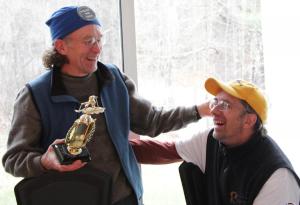 “There is a power to looking at hierarchical systems and seeing that they are ultimately harmful to everyone,” said Jean O’Hara, professor of theater, gender studies, and environmental studies. Last spring, Jean co-taught a class with anthropology professor Nelli Sargsyan about the history, politics, and performance of drag (see page 18). “Our class was an opportunity to examine the ways different forms of oppression intersect with gender.”
“There is a power to looking at hierarchical systems and seeing that they are ultimately harmful to everyone,” said Jean O’Hara, professor of theater, gender studies, and environmental studies. Last spring, Jean co-taught a class with anthropology professor Nelli Sargsyan about the history, politics, and performance of drag (see page 18). “Our class was an opportunity to examine the ways different forms of oppression intersect with gender.”
This issue of Potash Hill touches on that complexity of gender expression from several points of view, from professor Kristin Horrigan’s exploration of gender identity through contact improvisation (page 8) to the pioneering documentaries of trans culture by alumnus André Pérez (page 44). Jean and Nelli’s class provides a valuable opportunity for Marlboro students to reimagine a world where all expressions of gender are allowed, and what that would look like on stage.
Marlboro is a bastion of freedom of expression, gendered or otherwise, so it is timely during this period of political uncertainty and fear that we share alumna Olivia Palermo’s study of free speech on campus (page 14). Although Olivia concedes that upholding freedom of speech is easy when people share a common set of values, she argues that views of intolerant liberalism on college campuses are too simplistic. A shining example of the typical complexity of thoughtful speech can be found in student Fiona Craig’s essay about the dangers of criminal proceedings in cases of intimate partner violence (page 23).
All that and more, of course. This issue is packed with new partnerships, programs, events, and activities of our esteemed faculty members and far-flung alumni. This includes a heartfelt nod to OP director Randy Knaggs (pictured above with yours truly), who is stepping back from most of his responsibilities at the college for health reasons (page 43).
As always, I welcome your news, your views, your reactions to this treasure trove known as Potash Hill. Where do you draw the line between fear and freedom? Between gender identity and gender expression? Share your perspective with us at pjohansson@marlboro.edu.
—Philip Johansson
Inside Front Cover
Potash Hill
Published twice every year, Potash Hill shares highlights of what Marlboro College community members, in both undergraduate and graduate programs, are doing, creating, and thinking. The publication is named after the hill in Marlboro, Vermont, where the undergraduate campus was founded in 1946. “Potash,” or potassium carbonate, was a locally important industry in the 18th and 19th centuries, obtained by leaching wood ash and evaporating the result in large iron pots. Students and faculty at Marlboro no longer make potash, but they are very industrious in their own way, as this publication amply demonstrates.
Chief External Relations Officer: Matthew Barone
Alumni Director: Kathy Waters
Editor: Philip Johansson
Photo Editor: Ella McIntosh
Staff Photographers: Clayton Clemetson ’18 and David Teter ’19
Design: New Ground Creative
Potash Hill welcomes letters to the editor. Mail them to: Editor, Potash Hill, Marlboro College, P.O. Box A, Marlboro, VT 05344, or send email to pjohansson@marlboro.edu. The editor reserves the right to edit for length letters that appear in Potash Hill.
Front Cover: Students relax by the campfire during training for this fall’s Bridges orientation trips. Leaders are charged with welcoming new students and engendering a sense of inclusion and community engagement that will set them up to succeed at Marlboro. Photo by David Teter
 “For me, exploring my intellectual interests and my personal interests are more connected than I thought they were,” says Nick Creel ’20 (right). “Why am I so passionate about certain issues? Well, they pertain to how I feel and who I am as a person.” Learn about Nick’s interests and his views on gender expression. Photo by Kelly Fletcher
“For me, exploring my intellectual interests and my personal interests are more connected than I thought they were,” says Nick Creel ’20 (right). “Why am I so passionate about certain issues? Well, they pertain to how I feel and who I am as a person.” Learn about Nick’s interests and his views on gender expression. Photo by Kelly Fletcher
About Marlboro College
Marlboro College provides independent thinkers with exceptional opportunities to broaden their intellectual horizons, benefit from a small and close-knit learning community, establish a strong foundation for personal and career fulfillment, and make a positive difference in the world. At our undergraduate campus in the town of Marlboro, Vermont, and our graduate center in Brattleboro, students engage in deep exploration of their interests—and discover new avenues for using their skills to improve their lives and benefit others—in an atmosphere that emphasizes critical and creative thinking, independence, an egalitarian spirit, and community.
Up Front
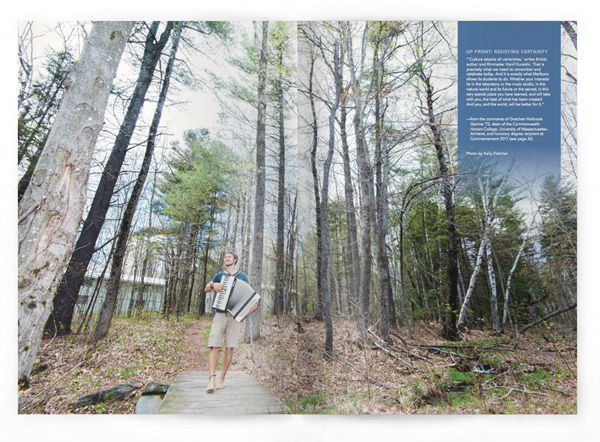
Resisting Certainty
“‘Culture attacks all certainties,’ writes British author and filmmaker Hanif Kureishi. That is precisely what we need to remember and celebrate today. And it is exactly what Marlboro allows its students to do. Whether your interests lie in the laboratory or the music studio, in the natural world and its future or the sacred, in this very special place you have learned, and will take with you, the best of what has been created. And you, and the world, will be better for it.”
— from the comments of Gretchen Holbrook Gerzina ’72, dean of the Commonwealth Honors College, University of Massachusetts– Amherst, and honorary degree recipient at Commencement 2017 (see page 36)
Photo by Kelly Fletcher
Clear Writing
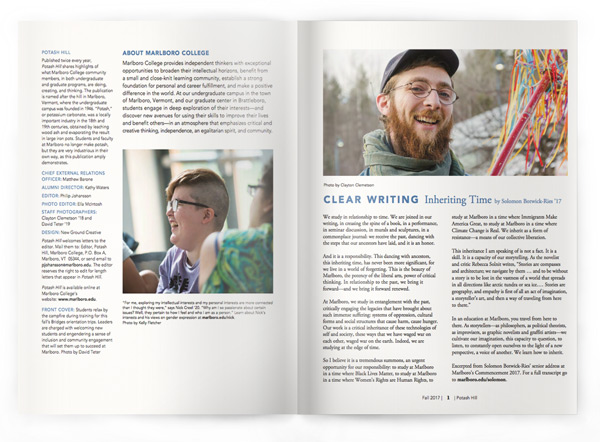
Inheriting Time
by Solomon Botwick-Ries ’17
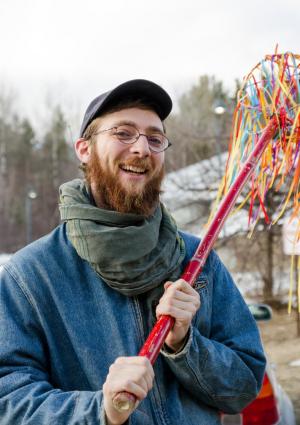 We study in relationship to time. We are joined in our writing, in creasing the spine of a book, in a performance, in seminar discussion, in murals and sculptures, in a commonplace journal: we receive the past, dancing with the steps that our ancestors have laid, and it is an honor.
We study in relationship to time. We are joined in our writing, in creasing the spine of a book, in a performance, in seminar discussion, in murals and sculptures, in a commonplace journal: we receive the past, dancing with the steps that our ancestors have laid, and it is an honor.
And it is a responsibility. This dancing with ancestors, this inheriting time, has never been more significant, for we live in a world of forgetting. This is the beauty of Marlboro, the potency of the liberal arts, power of critical thinking. In relationship to the past, we bring it forward—and we bring it forward renewed.
At Marlboro, we study in entanglement with the past, critically engaging the legacies that have brought about such immense suffering: systems of oppression, cultural forms and social structures that cause harm, cause hunger. Our work is a critical inheritance of these technologies of self and society, these ways that we have waged war on each other, waged war on the earth. Indeed, we are studying at the edge of time.
So I believe it is a tremendous summons, an urgent opportunity for our responsibility: to study at Marlboro in a time where Black Lives Matter, to study at Marlboro in a time where Women’s Rights are Human Rights, to study at Marlboro in a time where Immigrants Make America Great, to study at Marlboro in a time where Climate Change is Real. We inherit as a form of resistance—a means of our collective liberation.
This inheritance I am speaking of is not a fact. It is a skill. It is a capacity of our storytelling. As the novelist and critic Rebecca Solnit writes, “Stories are compasses and architecture; we navigate by them … and to be without a story is to be lost in the vastness of a world that spreads in all directions like arctic tundra or sea ice.… Stories are geography, and empathy is first of all an act of imagination, a storyteller’s art, and then a way of traveling from here to there.”
In an education at Marlboro, you travel from here to there. As storytellers—as philosophers, as political theorists, as improvisers, as graphic novelists and graffiti artists—we cultivate our imagination, this capacity to question, to listen, to constantly open ourselves to the light of a new perspective, a voice of another. We learn how to inherit.
Excerpted from Solomon Botwick-Ries’ senior address at Marlboro’s Commencement 2017. See a full transcript.
Photo by Clayton Clemetson
Letters
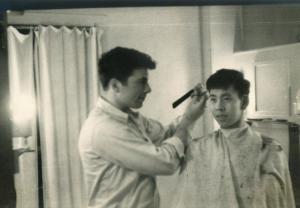 Looking for Frank Perenick ’53
Looking for Frank Perenick ’53
I graduated from East Longmeadow High School, in Massachusetts, and administer our Class of ’70 website. One of our fifth-grade teachers was Mr. Francis Perenick, a Marlboro alumnus, and I’m seeking a photo of him to add to our site. I’m wondering if you could scan and email me his graduation photo from the yearbook: something that would be a good likeness of him that we would remember.
—Scott Moore, friend
We could not find a photo of Frank graduating, but found this great, fuzzy one (right) of him giving a haircut, which we shared. —eds
Freshman Memories
I would like to tell an anecdote about Ellsworth Mason, who taught freshman literature. He sent a note home to my parents at Christmastime saying I wasn’t putting in enough time studying for his class even though he knew I was getting top marks for my other classes. He thought I was just going through the motions in his. Needless to say, I was really chewed out by my parents. I wasn’t angry at professor Ellsworth, but rather impressed that he cared enough to try to stimulate my interest in his class, which was the most difficult and challenging I have ever taken.
—Irwin Rosen ’55
Free Speech Fundamentalism
As an alumnus and a first amendment fundamentalist, I found the protest by Middlebury students at a talk by Charles Murray, as reported in the New York Times in March (goo.gl/u2yYhh), highly disturbing. All ideas should be welcome for exploration. Explore racism if you want to understand it. Explore entropy if you want to figure out physics. Explore Robert Lowell if you want to get a handle on mania, and Sandburg if you want to know Chicago (or Wilco for you young folks). But please, please, get outside your comfort zone, kids. It is really easy to see all that is wrong in your own set and rail against it. But there is another set. They don’t agree, and they are not dumb.
—Charlie Barmonde ’99
Remembering John MacArthur
A wise and wonderful man. As a member of the Brattleboro Union High School Science Advisory Committee in the ’80s and ’90s, John became one of my truly great science mentors. I loved his gentle, confident, and holistic approach to science. His children and grandchildren have many of his remarkable traits.
—Jim Maland, friend
Potash Love
As you already know, we are great fans of Potash Hill, and especially your graphic design. A beautiful piece of work in a world that is increasingly noisy.
—Will Morgan, friend
 More Jeep Memories
More Jeep Memories
Ana Bruce confirmed that her mom, Emilia Bruce ’58, is in the early photo of Marlboro pioneers on page 6 of Potash Hill Spring 2017 (right), and that Jon Glasby ’55 is in the jeep. However, the person to the right of the jeep, standing next to Howie Whittum ’55, is her dad, M. Linn Bruce ’55, not Charlie Staples.
Errata
We regret that we neglected to include a photo credit for the recent photo of Gail Henry ’72 on the inside back cover of Potash Hill Spring 2017. That photo was taken by Joya Pinkham Clark, also known as Owl Woman Design.
View from the Hill
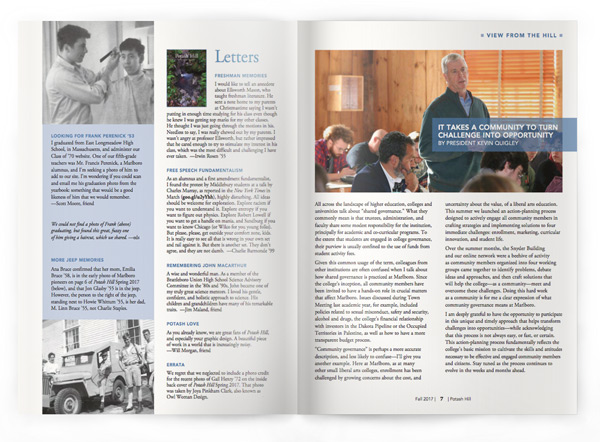
It Takes a Community to Turn Challenge into Opportunity
By President Kevin Quigley
All across the landscape of higher education, colleges and universities talk about “shared governance.” What they commonly mean is that trustees, administration, and faculty share some modest responsibility for the institution, principally for academic and co-curricular programs. To the extent that students are engaged in college governance, their purview is usually confined to the use of funds from student activity fees.
Given this common usage of the term, colleagues from other institutions are often confused when I talk about how shared governance is practiced at Marlboro. Since the college’s inception, all community members have been invited to have a hands-on role in crucial matters that affect Marlboro. Issues discussed during Town Meeting last academic year, for example, included policies related to sexual misconduct, safety and security, alcohol and drugs, the college’s financial relationship with investors in the Dakota Pipeline or the Occupied Territories in Palestine, as well as how to have a more transparent budget process.
“Community governance” is perhaps a more accurate description, and less likely to confuse—I’ll give you another example. Here at Marlboro, as at many other small liberal arts colleges, enrollment has been challenged by growing concerns about the cost, and uncertainty about the value, of a liberal arts education. This summer we launched an action-planning process designed to actively engage all community members in crafting strategies and implementing solutions to four immediate challenges: enrollment, marketing, curricular innovation, and student life.
Over the summer months, the Snyder Building and our online network were a beehive of activity as community members organized into four working groups came together to identify problems, debate ideas and approaches, and then craft solutions that will help the college—as a community—meet and overcome these challenges. Doing this hard work as a community is for me a clear expression of what community governance means at Marlboro.
I am deeply grateful to have the opportunity to participate in this unique and timely approach that helps transform challenges into opportunities—while acknowledging that this process is not always easy, or fast, or certain. This action-planning process fundamentally reflects the college’s basic mission to cultivate the skills and attitudes necessary to be effective and engaged community members and citizens. Stay tuned as the process continues to evolve in the weeks and months ahead.
Gender in the Way We Move
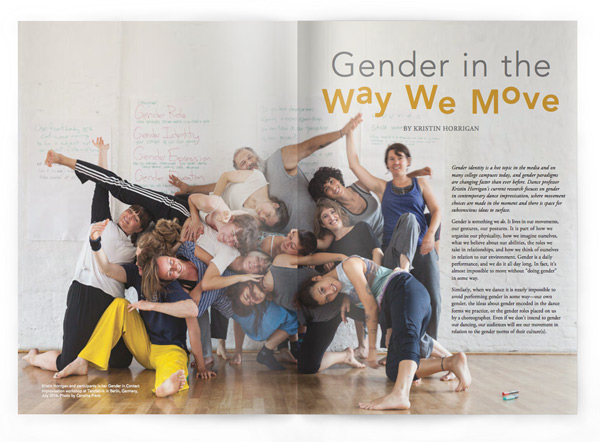
By Kristin Horrigan
Gender identity is a hot topic in the media and on many college campuses today, and gender paradigms are changing faster than ever before. Dance professor Kristin Horrigan’s current research focuses on gender in contemporary dance improvisation, where movement choices are made in the moment and there is space for subconscious ideas to surface.
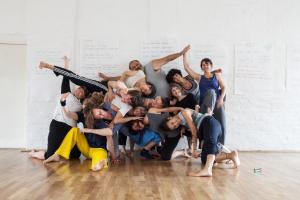 Gender is something we do. It lives in our movements, our gestures, our postures. It is part of how we organize our physicality, how we imagine ourselves, what we believe about our abilities, the roles we take in relationships, and how we think of ourselves in relation to our environment. Gender is a daily performance, and we do it all day long. In fact, it’s almost impossible to move without “doing gender” in some way.
Gender is something we do. It lives in our movements, our gestures, our postures. It is part of how we organize our physicality, how we imagine ourselves, what we believe about our abilities, the roles we take in relationships, and how we think of ourselves in relation to our environment. Gender is a daily performance, and we do it all day long. In fact, it’s almost impossible to move without “doing gender” in some way.
Similarly, when we dance it is nearly impossible to avoid performing gender in some way—our own gender, the ideas about gender encoded in the dance forms we practice, or the gender roles placed on us by a choreographer. Even if we don’t intend to gender our dancing, our audiences will see our movement in relation to the gender norms of their culture(s).
Gender is a social construction. The term gender refers to a particular culture’s ideas about what behaviors and attitudes are expected of people based on their biological sex and its intersection with other factors, including age, role in society, race, class, and sexual preference. In most Western cultures over the past several hundred years, gender has been constructed as a binary, with masculine and feminine understood as the only two options. More and more in Western cultures, this binary is cracking open, revealing many more than two possibilities, including transgender, gender neutral, gender fluid, and genderqueer identities, plus a range of different masculinities and femininities.
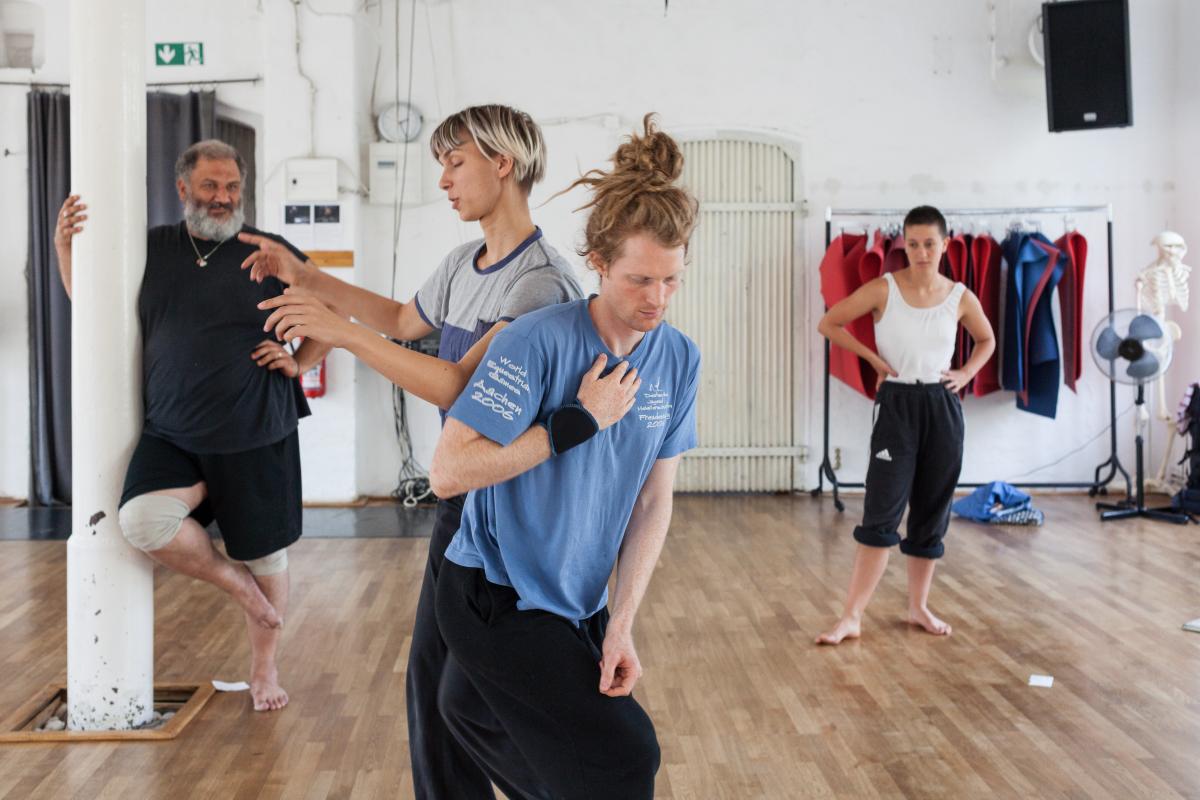 Our ideas about gender are projected onto us when we are very young. We begin learning about gender roles in early childhood, absorbing messages from a wide variety of sources: family members, school, toys and games, clothing, the media, and so on. Even though most of us eventually form our own conscious gender identities as adults, we still carry with us the gender education we accumulated during our early years. This cultural knowledge is deeply embedded within us, stored in our bodies as much as in our thoughts. We sometimes perform gender roles that are habitual to us, even if we no longer support or identify with them. Our gender expression doesn’t always match our gender identity—especially when we are dancing.
Our ideas about gender are projected onto us when we are very young. We begin learning about gender roles in early childhood, absorbing messages from a wide variety of sources: family members, school, toys and games, clothing, the media, and so on. Even though most of us eventually form our own conscious gender identities as adults, we still carry with us the gender education we accumulated during our early years. This cultural knowledge is deeply embedded within us, stored in our bodies as much as in our thoughts. We sometimes perform gender roles that are habitual to us, even if we no longer support or identify with them. Our gender expression doesn’t always match our gender identity—especially when we are dancing.
In dancing, particularly in improvisational dancing, our embodied knowledge—both the conscious and the subconscious—comes forth. We make choices about how to take up space, how to organize our bodies, how soft or hard to make our movements, how vulnerable to let ourselves be, how to interact with others, how to present ourselves to an audience. Because of our gender education, we have more practice with certain gestures, postures, movement qualities, and ways of relating to space than with others. These habits and patterns emerge among our more conscious choices. For example, as a feminine-educated person, I have been taught to have a soft, flowing, yielding movement quality, and this comes up quite frequently in my dancing, whenever I’m not making a conscious choice. Strong, direct actions are less familiar to me and take more conscious thought.
Most notions of gender are inherently limiting, and certainly the binary gender education that most of us were exposed to as children was based entirely on limits. Girls are quieter and better behaved, boys are more physical and energetic, girls should smile and look pretty, boys don’t cry, and so forth. But our dancing need not be restricted in this way. What movement possibilities are we excluding when we allow gender to shape our movement? How could awareness of the way gender is affecting our movement offer us greater range and freedom of expression in our dancing?
These questions have been at the heart of my research for the past several years. They’ve been particularly interesting to explore in the dance form called contact improvisation (CI), an athletic dance of improvised partnering. In this dance, the dancers explore the movement that is possible when two bodies are in physical contact, using each other’s support to balance and communicating through weight and momentum. As the dancers lift each other, fall and roll together, they are constantly responding to their partner. Their attitudes toward strength and vulnerability, risk taking and protection, leading and following are all revealed through their movements.
Emerging from the avant-garde dance performance scene in the early 1970s in the U.S., contact improvisation embodies some of the popular politics of its day. Influenced by the feminist movement, contact improvisation contains no set gender roles. People of any gender can dance together, and all movement possibilities are open to every dancer. There are no leader or follower roles. No roles at all, in fact, except those one might take on spontaneously in the course of a particular dance.
 In fact, to dance contact improvisation well, one must embody a range of qualities and skills from across the gender spectrum. All CI dancers need to support and be supported, to initiate and follow, to be soft and to be strong, to sense and to act. In combining both masculine- and feminine-coded qualities, CI technique actively queers gender, inviting us all to play beyond the confines of the binary.
In fact, to dance contact improvisation well, one must embody a range of qualities and skills from across the gender spectrum. All CI dancers need to support and be supported, to initiate and follow, to be soft and to be strong, to sense and to act. In combining both masculine- and feminine-coded qualities, CI technique actively queers gender, inviting us all to play beyond the confines of the binary.
For this reason, contact improvisation has the potential to be a paradise of gender freedom. Indeed, some of my transgender students at Marlboro have said that contact improvisation class allowed them the most freedom they’ve ever experienced from societal pressures around gender.
And students of all genders have noted the room CI gives them to try out ways of moving that they’ve previously denied themselves, including movements that are gender coded. And at the same time, contact improvisation is a dance form to which we bring our full selves—our creativity, our physicality, our histories, and yes, our genders and our sexuality. Very often, patriarchal and heteronormative patterns creep in. For example, it may be more familiar and comfortable for a masculine-educated person to lead their partner, to lift rather than be lifted, and to favor movements that depend on strength rather than those that require vulnerability. However, this is very limiting to their dancing and to the person dancing with them.
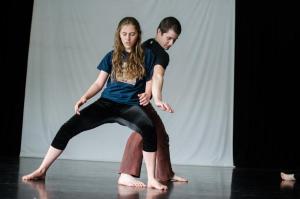 In order to achieve the potential freedom of the dance, dancers need to raise their awareness of how their gender education and their gender identity are influencing their choices on the dance floor. Whether or not a person chooses to inhabit a traditional gender role off the dance floor, within the dance form of contact improvisation observing a fixed gender role restricts one’s ability to participate fully in the dance.
In order to achieve the potential freedom of the dance, dancers need to raise their awareness of how their gender education and their gender identity are influencing their choices on the dance floor. Whether or not a person chooses to inhabit a traditional gender role off the dance floor, within the dance form of contact improvisation observing a fixed gender role restricts one’s ability to participate fully in the dance.
A first step is to understand better how gender lives in movement. I suggest you try an experiment. Pick a simple daily action—for example, sitting down in a chair, opening a bottle, or taking off a sweater—and perform it your usual way. (Yes, really do it!) Then try it again a few times with “more masculinity,” “more femininity,” more gender neutrality, more queerness, and so on. Yes, you are drawing on stereotypes to do this. While often exaggerated, stereotypes provide valuable information about (your embodied) cultural ideas around gender. You may notice that you have a number of different ideas about what it means to be masculine, feminine, gender neutral, or genderqueer. Try them all.
What do you notice changing when you attempt to add more masculinity, femininity, gender neutrality, or queerness to your movement? What changes in terms of how much space you use, how much of the body is involved, how conscious you are of how you look, how much force you use, how efficient the movement is, how much of the body contributes to the action, how direct or indirect the pathways are? Can you imagine how these gender-coded ways of movement could translate beyond daily gestures into the broader actions of dancing?
If this experiment makes you curious, I encourage you to look up Iris Marion Young’s classic gender theory article “Throwing Like a Girl,” in which she theorizes about gendered mobility and spatiality. Young draws connections between attitudes toward children (for example, that little girls should take more care not to get hurt or dirty) and movement patterns that last into adult life (for example, that feminine-educated people are more likely to hesitate before taking a physical risk, thus causing a disconnection between intention and action). While times have changed much in the nearly 40 years since Young wrote this article, many of her ideas are still found in our bodies today.
Deepening the investigation, dancers can ask themselves questions about how they interact with their dance partners. What roles do they take in CI dances? Instigator? Listener? Caretaker? Clown? Do they offer different dances to people of different genders? Do they expect different things from their dance partners based on what they perceive as their gender?
If dancers ignore questions about gender and continue to perform it unconsciously in their contact improvisation, they limit the kinds of dances they can have, the diversity of the community that practices CI, and the possibility to step out from under the gendered expectations of their societies.
When we take the time to notice and question our own gendered patterns of movement and interaction, we help liberate ourselves from the limits of our gender education—both in our dancing and in our daily lives. This allows us a greater range of possibilities in our movement and more space to truly listen to the dance that is happening. When we learn to stop making assumptions about each other’s gender (and sex and sexuality) and stop treating each other in gendered ways on the dance floor, we can begin to make our communities more inclusive of queer and gender-nonconforming people. Lastly, by questioning the gendered behaviors that emerge in our dancing and in our daily actions, we invite critical reflection on power structures both in and outside the space we are occupying.
Kristin Horrigan is a professor of dance and gender studies, and an internationally known teacher of contact improvisation. Her research on CI and gender was recently published in the Winter/Spring 2017 issue of Contact Quarterly, in an article titled “Queering Contact Improvisation.”
Body Memories
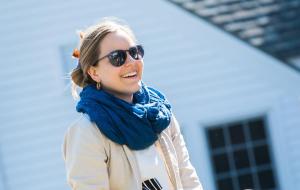 “Contact improvisation was influential in how I began to view my body and movement habits with other dancers,” says senior Lucy Hammond, who is working on her Plan in anthropology and dance/gender studies. “CI is the most intentionally gender-neutral and physically accessible space that I have experienced as a dancer. There are far fewer borders and ‘shoulds’ and ‘should nots.’” Lucy’s research explores gender conditioning and performance through movement and thought patterns. She is investigating her own gender performance and facilitating workshops allowing others the space to research memories of gendered experiences as well. “We will look at how habits might mask discomfort, or take away or give bodily space and voice,” says Lucy. “Understanding gender performance and its origins, growth, and deconstruction brings into question coloniality, hetero-patriarchy, and their memory in bodies.”
“Contact improvisation was influential in how I began to view my body and movement habits with other dancers,” says senior Lucy Hammond, who is working on her Plan in anthropology and dance/gender studies. “CI is the most intentionally gender-neutral and physically accessible space that I have experienced as a dancer. There are far fewer borders and ‘shoulds’ and ‘should nots.’” Lucy’s research explores gender conditioning and performance through movement and thought patterns. She is investigating her own gender performance and facilitating workshops allowing others the space to research memories of gendered experiences as well. “We will look at how habits might mask discomfort, or take away or give bodily space and voice,” says Lucy. “Understanding gender performance and its origins, growth, and deconstruction brings into question coloniality, hetero-patriarchy, and their memory in bodies.”
Fear v. Freedom on Campus
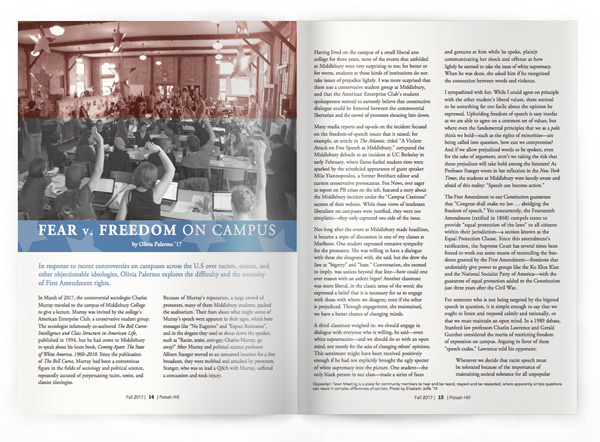
By Olivia Palermo ’17
In response to recent controversies on campuses across the U.S over racism, sexism, and other objectionable ideologies, Olivia Palermo explores the difficulty and the necessity of First Amendment rights.
In March of 2017, the controversial sociologist Charles Murray traveled to the campus of Middlebury College to give a lecture. Murray was invited by the college’s American Enterprise Club, a conservative student group. The sociologist infamously co-authored The Bell Curve: Intelligence and Class Structure in American Life, published in 1994, but he had come to Middlebury to speak about his latest book, Coming Apart: The State of White America, 1960–2010. Since the publication of The Bell Curve, Murray had been a contentious figure in the fields of sociology and political science, repeatedly accused of perpetuating racist, sexist, and classist ideologies.
Because of Murray’s reputation, a large crowd of protesters, many of them Middlebury students, packed the auditorium. Their fears about what might come of Murray’s speech were apparent in their signs, which bore messages like “No Eugenics” and “Expect Resistance”, and in the slogans they used to shout down the speaker, such as “Racist, sexist, anti-gay; Charles Murray, go away!” After Murray and political science professor Allison Stanger moved to an unnamed location for a live broadcast, they were mobbed and attacked by protesters. Stanger, who was to lead a Q&A with Murray, suffered a concussion and neck injury.
Having lived on the campus of a small liberal arts college for three years, none of the events that unfolded at Middlebury were very surprising to me; for better or for worse, students at these kinds of institutions do not take issues of prejudice lightly. I was more surprised that there was a conservative student group at Middlebury, and that the American Enterprise Club’s student spokesperson seemed to earnestly believe that constructive dialogue could be fostered between the controversial libertarian and the crowd of protesters shouting him down.
Many media reports and op-eds on the incident focused on the freedom-of-speech issues that it raised; for example, an article in The Atlantic, titled “A Violent Attack on Free Speech at Middlebury,” compared the Middlebury debacle to an incident at UC Berkeley in early February, where flame-fueled student riots were sparked by the scheduled appearance of guest speaker Milo Yiannopoulos, a former Breitbart editor and current conservative provocateur. Fox News, ever eager to report on PR crises on the left, featured a story about the Middlebury incident under the “Campus Craziness” section of their website. While these views of intolerant liberalism on campuses were justified, they were too simplistic—they only captured one side of the issue.
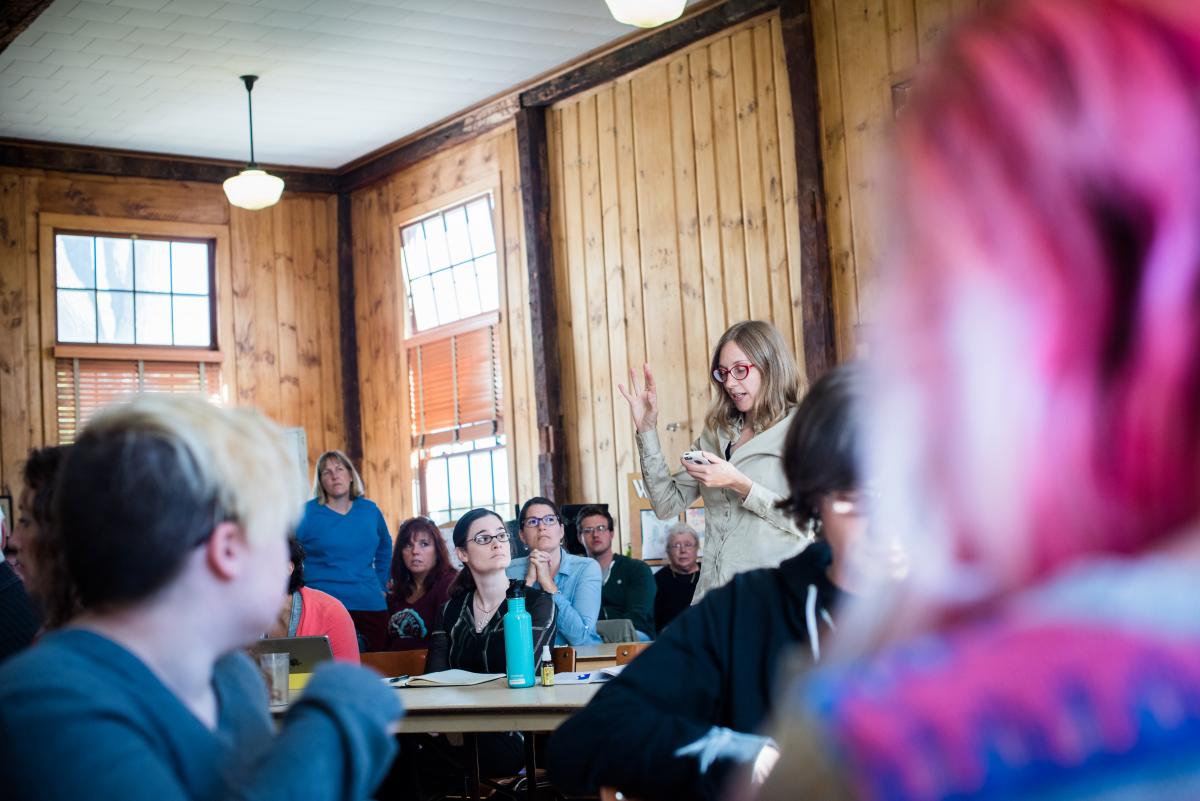 Not long after the event at Middlebury made headlines, it became a topic of discussion in one of my classes at Marlboro. One student expressed tentative sympathy for the protesters. She was willing to have a dialogue with those she disagreed with, she said, but she drew the line at “bigotry” and “hate.” Conversation, she seemed to imply, was useless beyond that line—how could one ever reason with an ardent bigot? Another classmate was more liberal, in the classic sense of the word: she expressed a belief that it is necessary for us to engage with those with whom we disagree, even if the other is prejudiced. Through engagement, she maintained, we have a better chance of changing minds.
Not long after the event at Middlebury made headlines, it became a topic of discussion in one of my classes at Marlboro. One student expressed tentative sympathy for the protesters. She was willing to have a dialogue with those she disagreed with, she said, but she drew the line at “bigotry” and “hate.” Conversation, she seemed to imply, was useless beyond that line—how could one ever reason with an ardent bigot? Another classmate was more liberal, in the classic sense of the word: she expressed a belief that it is necessary for us to engage with those with whom we disagree, even if the other is prejudiced. Through engagement, she maintained, we have a better chance of changing minds.
A third classmate weighed in: we should engage in dialogue with everyone who is willing, he said—even white supremacists—and we should do so with an open mind, not merely for the sake of changing others’ opinions. This sentiment might have been received positively enough if he had not explicitly brought the ugly specter of white supremacy into the picture. One student—the only black person in our class—made a series of faces and gestures at him while he spoke, plainly communicating her shock and offense at how lightly he seemed to take the issue of white supremacy. When he was done, she asked him if he recognized the connection between words and violence.
I sympathized with her. While I could agree on principle with the other student’s liberal values, there seemed to be something far too facile about the opinion he expressed. Upholding freedom of speech is easy insofar as we are able to agree on a common set of values, but where even the fundamental principles that we as a polis think we hold—such as the rights of minorities—are being called into question, how can we compromise? And if we allow prejudiced words to be spoken, even for the sake of argument, aren’t we taking the risk that those prejudices will take hold among the listeners? As Professor Stanger wrote in her reflection in the New York Times, the students at Middlebury were keenly aware and afraid of this reality: “Speech can become action.”
The First Amendment to our Constitution guarantees that “Congress shall make no law … abridging the freedom of speech.” Yet concurrently, the Fourteenth Amendment (ratified in 1868) compels states to provide “equal protection of the laws” to all citizens within their jurisdiction—a section known as the Equal Protection Clause. Since this amendment’s ratification, the Supreme Court has several times been forced to work out some means of reconciling the freedoms granted by the First Amendment—freedoms that undeniably give power to groups like the Ku Klux Klan and the National Socialist Party of America—with the guarantee of equal protection added to the Constitution just three years after the Civil War.
For someone who is not being targeted by the bigoted speech in question, it is simple enough to say that we ought to listen and respond calmly and rationally, or that we must maintain an open mind. In a 1989 debate, Stanford law professors Charles Lawrence and Gerald Gunther considered the merits of restricting freedom of expression on campus. Arguing in favor of these “speech codes,” Lawrence told his opponent:
Whenever we decide that racist speech must be tolerated because of the importance of maintaining societal tolerance for all unpopular speech, we are asking blacks and other subordinated groups to bear the burden for the good of all. We must be careful that the ease with which we strike the balance against the regulation of racist speech is in no way influenced by the fact that the cost will be borne by others. We must be certain that those who will pay that price are fairly represented in our deliberations and that they are heard.
Lawrence’s argument mirrors my own thoughts upon hearing my classmate’s contentious point of view about tolerance during that heated discussion. The history of racial discrimination and harm in the United States is deeper and more traumatic than many white people understand today. In the 2003 Supreme Court case of Virginia v. Black, which focused on a Virginia law that banned cross burning, justice Clarence Thomas—the only black Justice on the Supreme Court at the time— warned Virginia’s attorney not to understate the effect of the burning cross: “This was a reign of terror and the cross was a symbol of that reign of terror.… Isn’t that significantly greater than intimidation or a threat?” The words of Lawrence and Thomas are a reminder of the gravity that certain kinds of speech can take on, even unintentionally.
Yet I fear that the ultimate consequences of restricting expression are greater than what may result from allowing it. Gunther, who was arguing against speech codes in the Stanford debate, described his experiences growing up as a Jewish person in Nazi Germany, “a country where ideological orthodoxy reigned and where the opportunity for dissent was severely limited.” I do not intend to make the argument that the United States will become akin to Nazi Germany if speech codes are allowed to remain; however, I do believe that we risk enforcing a kind of ideological orthodoxy if we permit any essential facet of our right of expression to be taken away from us, whether it is through the force of law, as in the case of ordinances against “hate speech,” or through the force of coercion, which is what the protestors at Middlebury utilized to ensure that their point of view would prevail over Murray’s. Those of us who value a liberal, democratic society should not compromise one of our fundamental constitutional rights in the belief that doing so will make us safer from harm.
What measures, then, can we resort to in order to insure that prejudicial or inaccurate views will not infect our communities? After the Middlebury incident, some writers weighed in with ideas for action that the protestors could have taken. Writing for The Chronicle of Higher Education, Catherine J. Ross explained that the Constitution “asks students, whether they’re 6 or 26, to use the traditional constitutional responses to vile speech: Walk away, don’t listen, or respond, as Justice Brandeis famously advised, with more and better speech.”
As my classmate suggested, some viewpoints— particularly the most virulent ones—cannot be reasoned with, because they do not possess any reason in themselves. In that case, Ross also suggested that students take measures similar to those of Michael K. Young, president of Texas A&M University: when the white supremacist Richard Spencer was invited to speak at the school, Young scheduled a counter-event called “Aggies United.” Young explained to an interviewer that, in his view, Spencer’s speech “doesn’t deserve a debate or protest” because “it’s beneath contempt.” Nonetheless, Young chose not to shut down Spencer’s event because he believed that his university must allow freedom of speech, even for the most contentious kinds of rhetoric.
Ultimately, the existence of the First Amendment means that there is no perfect solution to divisive or violent rhetoric; it can only be countered by protest, boycott, or “more and better speech.” Believing in the ability of speech to counter speech requires a certain amount of faith, a Lockean hope in individuals’ natural reason, which will incline them toward the common good. But even where such faith is impossible—as it may be for people in times of political upheaval—those citizens should not let fear stifle freedom.
Olivia Palermo graduated in May with a Plan of Concentration in politics. This article is excerpted and adapted from her Plan, titled “Words and the Imagination: Studies of the Effects of Rhetoric in Political Life.”
Teaching Social Justice
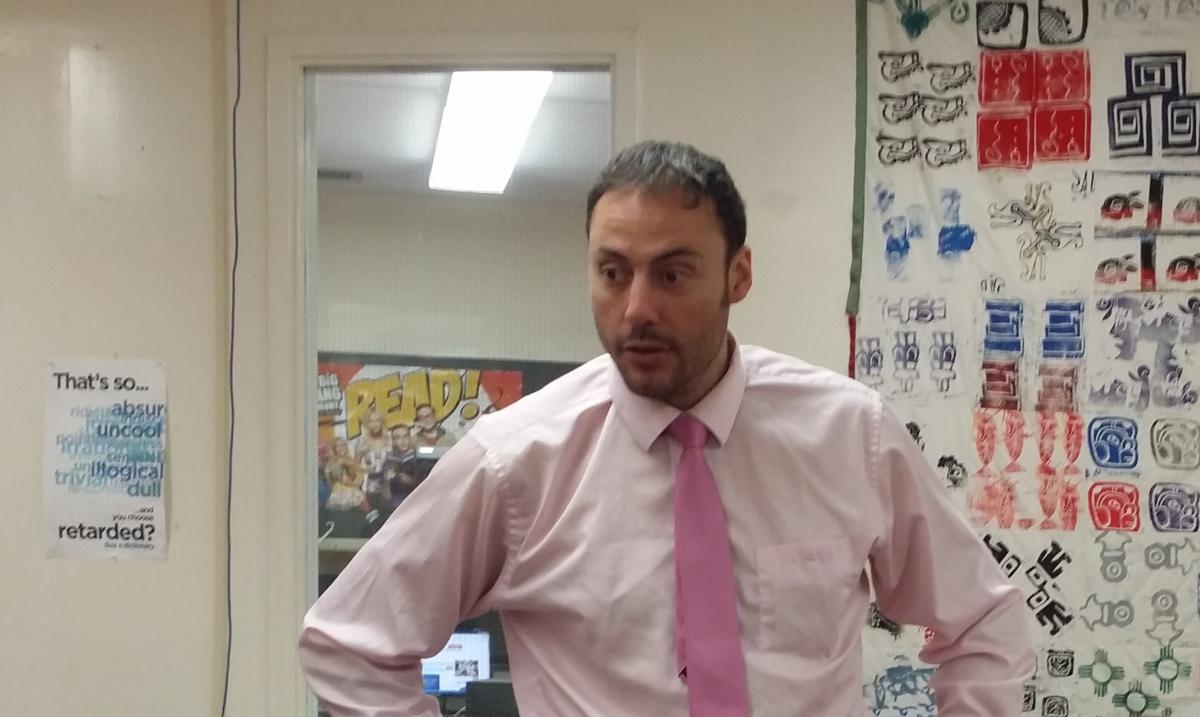 Taking social action toward the common good is hard enough on college campuses, but how about in middle school? In a Capstone Project titled “Declaring War on Apathy,” Mack Neal MAT ’17 designed a digital, interactive, and experiential learning framework to counteract student indifference and encourage advocacy and action. “The curriculum specifically targets student apathy toward social issues generated by white supremacism, and engages students by making them aware of the relevance that social issues have in their lives,” says Mack, a teacher at Leland and Gray Union Middle and High School in Townshend, Vermont. “In order to create a fair and balanced society, America’s teachers have the essential responsibility to provoke and evoke critical thought, empathy, advocacy, and action from their students. They must do this by implementing relevant, socially charged curricula that reflect diverse perspectives and cultures.”
Taking social action toward the common good is hard enough on college campuses, but how about in middle school? In a Capstone Project titled “Declaring War on Apathy,” Mack Neal MAT ’17 designed a digital, interactive, and experiential learning framework to counteract student indifference and encourage advocacy and action. “The curriculum specifically targets student apathy toward social issues generated by white supremacism, and engages students by making them aware of the relevance that social issues have in their lives,” says Mack, a teacher at Leland and Gray Union Middle and High School in Townshend, Vermont. “In order to create a fair and balanced society, America’s teachers have the essential responsibility to provoke and evoke critical thought, empathy, advocacy, and action from their students. They must do this by implementing relevant, socially charged curricula that reflect diverse perspectives and cultures.”
On and Off the Hill
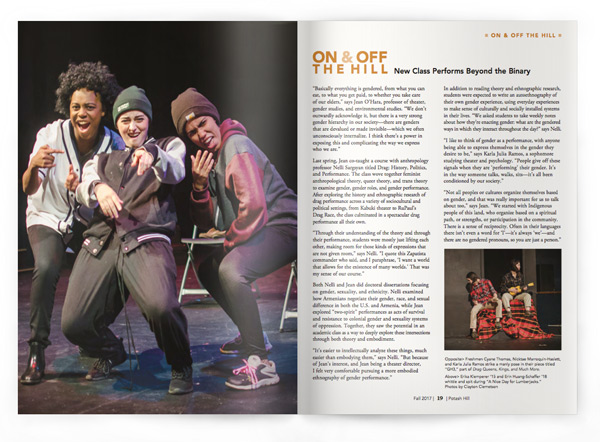
New Class Performs Beyond the Binary
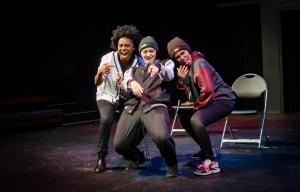 “Basically everything is gendered, from what you can eat, to what you get paid, to whether you take care of our elders,” says Jean O’Hara, professor of theater, gender studies, and environmental studies. “We don’t outwardly acknowledge it, but there is a very strong gender hierarchy in our society—there are genders that are devalued or made invisible—which we often unconsciously internalize. I think there’s a power in exposing this and complicating the way we express who we are.”
“Basically everything is gendered, from what you can eat, to what you get paid, to whether you take care of our elders,” says Jean O’Hara, professor of theater, gender studies, and environmental studies. “We don’t outwardly acknowledge it, but there is a very strong gender hierarchy in our society—there are genders that are devalued or made invisible—which we often unconsciously internalize. I think there’s a power in exposing this and complicating the way we express who we are.”
Last spring, Jean co-taught a course with anthropology professor Nelli Sargsyan titled Drag: History, Politics, and Performance. The class wove together feminist anthropological theory, queer theory, and trans theory to examine gender, gender roles, and gender performance. After exploring the history and ethnographic research of drag performance across a variety of sociocultural and political settings, from Kabuki theater to RuPaul’s Drag Race, the class culminated in a spectacular drag performance all their own.
“Through their understanding of the theory and through their performance, students were mostly just lifting each other, making room for those kinds of expressions that are not given room,” says Nelli. “I quote this Zapatista commander who said, and I paraphrase, ‘I want a world that allows for the existence of many worlds.’ That was my sense of our course.”
Both Nelli and Jean did doctoral dissertations focusing on gender, sexuality, and ethnicity. Nelli examined how Armenians negotiate their gender, race, and sexual difference in both the U.S. and Armenia, while Jean explored “two-spirit” performances as acts of survival and resistance to colonial gender and sexuality systems of oppression. Together, they saw the potential in an academic class as a way to deeply explore these intersections through both theory and embodiment.
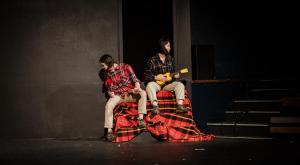 “It’s easier to intellectually analyze these things, much easier than embodying them,” says Nelli. “But because of Jean’s interest, and Jean being a theater director, I felt very comfortable pursuing a more embodied ethnography of gender performance.”
“It’s easier to intellectually analyze these things, much easier than embodying them,” says Nelli. “But because of Jean’s interest, and Jean being a theater director, I felt very comfortable pursuing a more embodied ethnography of gender performance.”
In addition to reading theory and ethnographic research, students were expected to write an autoethnography of their own gender experience, using everyday experiences to make sense of culturally and socially installed systems in their lives. “We asked students to take weekly notes about how they’re enacting gender: what are the gendered ways in which they interact throughout the day?” says Nelli.
“I like to think of gender as a performance, with anyone being able to express themselves in the gender they desire to be,” says Karla Julia Ramos, a sophomore studying theater and psychology. “People give off these signals when they are ‘performing’ their gender. It’s in the way someone talks, walks, sits—it’s all been conditioned by our society.”
“Not all peoples or cultures organize themselves based on gender, and that was really important for us to talk about too,” says Jean. “We started with Indigenous people of this land, who organize based on a spiritual path, or strengths, or participation in the community. There is a sense of reciprocity. Often in their languages there isn’t even a word for ‘I’—it’s always ‘we’—and there are no gendered pronouns, so you are just a person.”
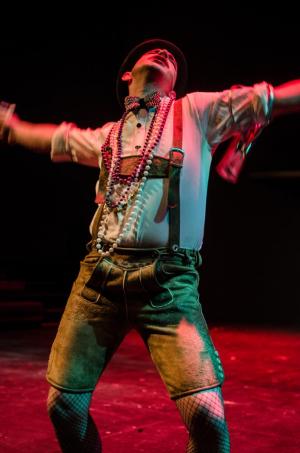 That kind of selfless collaboration and gender complexity was very evident in the class’s much anticipated April performance, titled Drag Queens, Kings, and Much More. Far from reinforcing the typical gender binary, and its inherent sexism, the show invited the audience to expand their understanding of gender expression through a series of very touching and personal acts. Performed once in Whittemore Theater and once at Hooker Dunham Theater in Brattleboro, the performance was a benefit for Green Mountain Crossroads, a nonprofit organization serving the local LGBTQ community.
That kind of selfless collaboration and gender complexity was very evident in the class’s much anticipated April performance, titled Drag Queens, Kings, and Much More. Far from reinforcing the typical gender binary, and its inherent sexism, the show invited the audience to expand their understanding of gender expression through a series of very touching and personal acts. Performed once in Whittemore Theater and once at Hooker Dunham Theater in Brattleboro, the performance was a benefit for Green Mountain Crossroads, a nonprofit organization serving the local LGBTQ community.
“By putting myself out there for the first time in my community and performing as a drag queen, let alone my first performance ever, I believe I was able to tap into my ability to produce a lasting effect,” says sophomore Day Rodriquez. “The audience’s support enhanced my confidence, and it was eye-opening to see my physical transformation unfold before my own eyes.” Day wrote an editorial for the Huffington Post about his experience: goo.gl/xEUAai.
“My favorite part of the drag show by far was that I was able to express myself and perform something I like to do—which is dancing—and to learn about myself in the process,” says sophomore Cyane Thomas. She is studying Korean popular culture and finds that gender performance plays a huge role in “K-Pop.” “The show and the class both made me realize that gender is expressed by individuals themselves, not by what society assigns.”
The production was co-created by all the performers, including Nelli and Jean, in an ensemble fashion. The students wrote scripts, choreographed movement, chose music, and determined the message they wanted to convey. Each student was involved in three or four acts, ranging from an interrogation of Bond-style “gentleman killers,” titled “007 Shakin’ & Stirred,” to an examination of gender, intercultural challenges, sexism, and the directions to Costco. There was humor, sadness, irony, and a sense of limitless possibilities.
“Not one of the pieces put anyone down or claimed power at the expense of someone else,” says Nelli, whose act with Jean in day-glow pantsuits, called “Otta Love,” was reprised on demand at the senior dinner before commencement.
“It was really amazing how many people said this was their favorite Marlboro show ever, because it wasn’t this polished piece,” says Jean. “I think it speaks to our desire, all of us, to see gender represented in a less heteronormative, binary way, to see something that is within us reflected back, even if we don’t get to express it—to live in a world with much more interesting, beautiful, layered, complex ways of expressing ourselves.” See an excerpt of the show.
Speech Matters Addresses Life after Incarceration
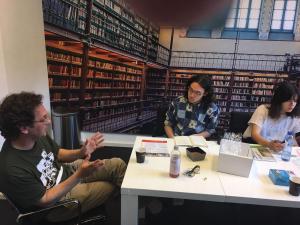 Following on its highly acclaimed first semester intensive in fall 2015 (Potash Hill, Fall 2015), Speech Matters returned this spring to focus on criminal justice reform. This year’s program looked at how politicians, social service providers, community members, and the recently incarcerated talk about responsibility, redemption, and the opportunity to move forward.
Following on its highly acclaimed first semester intensive in fall 2015 (Potash Hill, Fall 2015), Speech Matters returned this spring to focus on criminal justice reform. This year’s program looked at how politicians, social service providers, community members, and the recently incarcerated talk about responsibility, redemption, and the opportunity to move forward.
“The first iteration of Speech Matters focused on addiction and how rural and urban communities were dealing with the opioid epidemic,” says Meg Mott, politics professor and director of the semester intensive. “Some of the activists we met were in law enforcement and some had been formerly incarcerated—it made sense to broaden our network of partners into the criminal justice system.”
Each year, more than 700,000 individuals are released from prison, and another 9 million are sent home from local jails. Within three years, chances are strong that each of these individuals will re-offend and find themselves back in jail, suggesting that the school-to-prison pipeline only works in one direction. Together, Speech Matters students explored ways to improve the chances for those who have served their time.
“We front-loaded the theory,” says Jeff Hiam, a junior who participated in the semester. “We started out with reading Foucault—if you haven’t read that, it’s something else— and then read The New Jim Crow: Mass Incarceration in the Age of Colorblindness. That book really changed the national discourse on criminal justice, and it had a tremendous effect on me.”
In addition to looking at principles behind the various political arguments—libertarian, liberal, and conservative—students did much of their learning outside of the classroom, visiting correctional facilities and advocacy groups in Vermont, New Hampshire, Connecticut, and New York City.
“Since we were meeting with very different constituents— superintendents, formerly incarcerated leaders, defense attorneys, advocates—we were forced to hold some fairly significant differences of opinion in our collective imagination,” says Meg. “The classroom became a place to hold those differences without collapsing them into simplistic categories of ‘good’ and ‘bad.’ That’s a hard thing to do, especially when sharp judgment seems so helpful to the cause.”
The semester ended with a class trip to Amsterdam to provide students with a cross-cultural comparison and experience. The Netherlands has a much more humane approach to drug use than the United States, including supervised injection facilities known as “consumption rooms,” and has reduced the risk of overdose as well as the number of people going to prison. Many clients are non-Dutch nationals, people who would probably be criminalized in their home countries.
“In Amsterdam, we were able to see policy in action that was radically different from what we had seen in the U.S.,” says sophomore Eric Wefald. “People had a different outlook on prisoners and people who use drugs. It was crucial that we heard their stories and saw their practices in person.”
“Perhaps the most important observation was that harm reduction seemed to be part of the approach no matter what issue the individuals and organizations were focusing on,” says anthropology professor Nelli Sargsyan, who led the trip to Amsterdam. “We noticed it in the approach of the chief strategist of the Dutch police, the prison superintendents, the group home for formerly incarcerated people, and MDHG, a user-advocacy organization, to name a few. There seemed to be pragmatism involved in the decision making around these issues that was part of all our interlocutors’ thinking.”
Over the course of the semester, Speech Matters brought a rich program of speakers, films, and performers to Brattleboro to address the issue of mass incarceration, from criminal justice leader Glenn Martin to the renowned Everett Company Freedom Café, an event co-sponsored by Vermont Performance Lab. Their final event was a panel of student presenters talking about their individual projects, ranging from legal responses to intimate and sexual violence to a case study of a re-entry program in New Haven. See an excerpt of a panel discussion by the class.
Marlboro Collaborates with Mexican University
In May, Marlboro College signed a collaboration agreement with the Autonomous University of San Luis Potosí (UASLP), in central Mexico, for academic and research exchanges. The agreement will ensure that future students and faculty from each institution can spend time at the other to conduct research and take courses in their areas of interest.
“The city of San Luis Potosi is a jewel of the Baroque period, and our students will love walking around the plazas and exploring the different natural and geological regions in the area,” says Rosario de Swanson, professor of Spanish language and literature, who was instrumental in making the UASLP agreement a reality. She also found that, like Marlboro, UASLP values interdisciplinary perspectives and curricular innovation. They also offer several programs unavailable at Marlboro, including geography, archaeology, and paleontology.
“This exchange agreement with UASLP offers another exciting opportunity for students to study off the hill,” says Richard Glejzer, provost and dean of faculty. “We have three exchange programs in Europe now (Germany, Czech Republic, and Slovakia) and one in China—this will be our first in Latin America.” Learn more.
College Creates English for Refugees Fellowship
In February, Marlboro College and the U.S. Committee for Refugees and Immigrants (USCRI) signed a partnership to create the English for Refugees Fellowship. This inspiring fellowship will enable students in Marlboro’s MA in Teaching English to Speakers of Other Languages (TESOL) program to serve at one of six resettlement centers in the U.S., and to teach English to refugees and immigrants while completing their graduate degree.
“USCRI is a nationally recognized nonprofit that has worked toward protecting the rights of displaced peoples for over 100 years,” says Beverley Burkett, chair of Marlboro’s MATESOL program. “We are thrilled to be able to collaborate with them and support their mission while training educators who will make a positive contribution. We hope to develop a cohort of teachers who are sensitive to the needs of a population that has experienced the trauma of displacement, who recognize their resiliency, and who will support these people in creating dignified, independent lives in their new homes.”
Marlboro welcomed their first English for Refugees Fellows this summer, and marked their summer residency with a five-part speaker series on refugees in the U.S. The series included eminent authorities on the subject, ranging from Amila Merdzanovic, former refugee and now leader of the USCRI Vermont field office, to Lloyd Dakin, retired senior officer for the UN High Commissioner for Refugees.
Positive Sexuality on Campus
By Robyn Manning-Samuels ’14
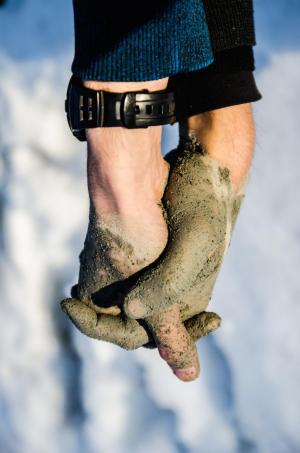 In 2011, the Obama administration issued a “Dear Colleague” letter to schools, colleges, and universities that receive federal funding, with directives for how to interpret Title IX and adjudicate sexual misconduct cases. Among the new regulations were descriptions of how prevention and awareness programs should look, including initiatives “intended to end dating violence, domestic violence, sexual assault, and stalking.” The programs had to be culturally relevant, inclusive of diverse communities and identities, and sustainable, among other admirable criteria.
In 2011, the Obama administration issued a “Dear Colleague” letter to schools, colleges, and universities that receive federal funding, with directives for how to interpret Title IX and adjudicate sexual misconduct cases. Among the new regulations were descriptions of how prevention and awareness programs should look, including initiatives “intended to end dating violence, domestic violence, sexual assault, and stalking.” The programs had to be culturally relevant, inclusive of diverse communities and identities, and sustainable, among other admirable criteria.
One of the major criticisms of the Dear Colleague letter was the capacity of college campuses to meet these new regulations. Many schools have found it hard to divert resources away from adjudicating sexual misconduct cases and supporting survivors to create a more comprehensive prevention and awareness program. Meanwhile, campus prevention efforts are quickly becoming culturally irrelevant as the focus of research moves away from consent as just “yes and no” to a larger conversation that focuses on sexual pleasure, healthy relationships, and healthy communication.
The work I’m doing at Marlboro College is focused on what is quickly becoming the norm among rape prevention specialists and experts: consent as positive sexuality. The philosophy behind positive sexuality is, “All forms of sexuality are healthy and encouraged as long as the expression of that sexuality is consensual.” Reframing consent through the lens of positive sexuality not only meets new federal regulations, but is a missing link in the conversation around sexual assault prevention. Through a positive sexuality lens, we can focus our efforts on helping students navigate the nuances of consent in a meaningful way.
Positive sexuality programs at Marlboro are intentionally designed to educate students on healthy consent and relationships and to create increasingly nuanced conversations around consent. In order to keep the workshops inclusive and open, I hire expert sex educators who are well versed in the myriad ways that intersecting identities affect conversations around consent. The fall semester begins with “Healthy Me,” focusing on the healthy individual, because much of the work around relationships and consent begins with an understanding of personal needs and boundaries. In the spring the conversation shifts to “Healthy Us” and conversations about navigating relationships, partners, and how to be a good bystander in instances of intimate partner violence.
A common criticism of positive sexuality programs is the relative absence of conversations around the violence of sexual assault—a shift away from the history of prevention programs focused on the horror of rape and abuse. An effective positive sexuality program series needs to include “solidarity” events focused on creating space for survivors to voice their experiences, challenge rape culture, and name violent behaviors. This is something Marlboro continues to work on as part of a larger shift away from framing campus events like Take Back the Night as “prevention.” With both prevention and solidarity programs happening simultaneously, college campuses will look very different than they ever have before.
The last crucial piece involves trained peer educators and advocates. At Marlboro, I created a program called the Consent Cavalry, which provides students (and staff and faculty, if they wish) with 25 to 35 hours of education and training to prepare them to be educators, advocates, and resources to their peers. In many ways, the real work is happening in peer-to-peer conversation about sexuality, relationships, and drugs and alcohol. Members of the Consent Cavalry know how to report instances of alleged policy violations, who the resources are on and off campus and how to get in touch with them, and how to be an empathetic responder and active bystander.
Community members like those in the Consent Cavalry are where the real culture shift happens, and it is already starting at Marlboro. Students are being more thoughtful about their habits, seeking out resources when they need them, and having real conversations about consent in their day-to-day lives. With culturally relevant and inclusive programming, in compliance with federal regulations, positive sexuality could become the new norm in the conversation around consent and relationships; students could be taught to swim instead of being told not to drown. This is how you change culture, and this is how you truly prevent sexual assault.
Robyn Manning-Samuels is senior coordinator of sexual respect and wellness, and survivor advocate, at Marlboro College.
Also of Note
 “It’s a great opportunity, especially if the graduate school has a program that could relate to a student’s Plan, or even just help them along with their future,” says Cat Clauss ’17 (right), the first undergraduate to enroll in the new accelerated master’s track. Cat, who did her Plan in the psychology of career development, will continue to earn her MSM, with a concentration in mission-driven organizations, this fall. The accelerated master’s track can also lead to MAT degrees in TESOL, ed tech, and social justice, as well as an MBA. Learn more at goo.gl/P4gu9r.
“It’s a great opportunity, especially if the graduate school has a program that could relate to a student’s Plan, or even just help them along with their future,” says Cat Clauss ’17 (right), the first undergraduate to enroll in the new accelerated master’s track. Cat, who did her Plan in the psychology of career development, will continue to earn her MSM, with a concentration in mission-driven organizations, this fall. The accelerated master’s track can also lead to MAT degrees in TESOL, ed tech, and social justice, as well as an MBA. Learn more at goo.gl/P4gu9r.
Sophomore Cyane Thomas spent most of the summer in Seoul, South Korea, learning Korean and taking a course about the globalization of K-pop. “It’s super exciting because the classes fall in perfectly with what I plan to study at Marlboro, which is Korean pop music,” she says. A highlight was going to a music television show to watch various K-pop groups perform and promote their most recent musical releases. “I was excited to see these individuals sing and dance their hearts out with my own eyes instead of on a screen.” Learn more about Cyane’s work at goo.gl/rrnuGj.
Marlboro College made the short list for “10 colleges where joining student clubs is easy,” released in February by U.S. News and World Report. Drawn from U.S. News’ survey of more than 1,800 colleges and universities nationally, Marlboro is the only New England college in the top 10, tieing second with Hamilton College in New York State. “Since the typical club at these colleges had fewer than 10 people, the odds are higher that club members will get to know each other than at colleges where clubs are larger,” said the article.
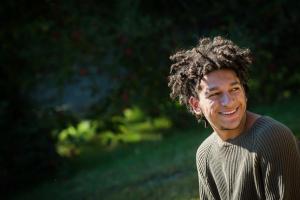 “It was such a privilege to live and study in a place whose beauty is so immediately apparent yet so enigmatic,” says junior Andrew Domzal (right), who studied abroad last semester at Charles University in Prague, Czech Republic. Andrew was the first student to participate in Marlboro’s exchange program with Charles, where he studied philosophy and film. “There is something about a change of atmosphere that I believe to be essential, not just to philosophical or academic growth, but to the cultivation of the self. As I prepare myself for Plan, I can’t think of an experience that would have given me the same gifts that my time in Prague did.”
“It was such a privilege to live and study in a place whose beauty is so immediately apparent yet so enigmatic,” says junior Andrew Domzal (right), who studied abroad last semester at Charles University in Prague, Czech Republic. Andrew was the first student to participate in Marlboro’s exchange program with Charles, where he studied philosophy and film. “There is something about a change of atmosphere that I believe to be essential, not just to philosophical or academic growth, but to the cultivation of the self. As I prepare myself for Plan, I can’t think of an experience that would have given me the same gifts that my time in Prague did.”
On March 8, Marlboro students, faculty, and staff participated in a walk-out in solidarity with “A Day Without Women.” Participants gathered in the Snyder Gallery at noon to appreciate Diane Heileman’s Women’s March exhibit and to hear poems, quotes, and statistics about women’s empowerment and pay equity. Community members were then invited to visit a table in the dining hall where they could donate to the Women’s Freedom Center and fill out postcards to be sent to victims of hate crimes via the Local Love Brigade.
“The other coaches were definitely impressed by our talent and potential,” says Brennan Cofiell, a student in the MA in Teaching for Social Justice program and co-coach of the Twin Valley High School snowboard team. The team was featured in a Febuary Deerfield Valley News article, highlighting their strong season after four years without a team. Brennan is student teaching social studies at Twin Valley, in the classroom of co-coach Scott Salway. “I have always loved teaching,” says Brennan. “I have recently stepped away from working full time at the mountain and am working on my MAT.”
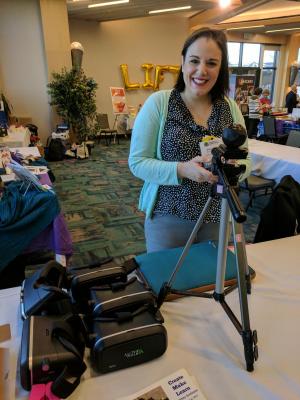 Teaching with Technology student Erica Zimmer (right) presented what her students were doing in virtual reality at May’s Dynamic Landscapes conference in Burlington, Vermont. “I was able to secure a grant to build a Makerspace at one of my schools, and I used part of the money to buy a 360 Camera and VR Goggles,” says Erica, a technology integration specialist in Rutland. Two girls used CoSpaces to build virtual reality spaces, one about wolves and the other about horses. “The next thing I know, their objects are moving around in their spaces, something that requires a bit of programming. They had taught themselves how to code!”
Teaching with Technology student Erica Zimmer (right) presented what her students were doing in virtual reality at May’s Dynamic Landscapes conference in Burlington, Vermont. “I was able to secure a grant to build a Makerspace at one of my schools, and I used part of the money to buy a 360 Camera and VR Goggles,” says Erica, a technology integration specialist in Rutland. Two girls used CoSpaces to build virtual reality spaces, one about wolves and the other about horses. “The next thing I know, their objects are moving around in their spaces, something that requires a bit of programming. They had taught themselves how to code!”
“Decadent chords cut through, creating a wild, untamed haze which is the foundation for Wild Rose,” said the Valley Advocate, in an admiring review of the new album of music by senior Bella Ortiz-Wren. Released on Bandcamp in April, Wild Rose is an astute exploration of “our physical selves inspiring emotions,” according to reviewer Will Meyer. “The album is wise beyond Ortiz-Wren’s 21 years, but also makes sense within this context as well. The investigation of bodies, aspirations, and limits is certainly age-appropriate— questions and quandaries that can linger a lifetime.” Learn more at goo.gl/r7bVL5.
Congratulations to Marceline Mitchell ’17, who was awarded this year’s “Check Me Out” award for checking out the most books from the library. “I spent so much time in the library, definitely more than any other building on campus—my dorm included—so the award was a really cool thing for me,” says Marceline, whose Plan in politics and philosophy was “An Exploration of the Making and Unmaking of the Democratic Subject.” She said she had 166 books checked out at the end of the semester, and estimates she checked out twice that many over the course of the year.
Mad Tea Party 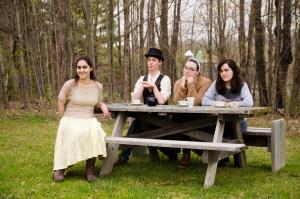 Seniors Phoebe Okoomian and John Marinelli, Lindsay Stevens ’17, and sophomore Cary Russell take five during the filming of Phoebe’s dance adaptation of Alice’s Adventures in Wonderland. Photo by Clayton Clemetson
Seniors Phoebe Okoomian and John Marinelli, Lindsay Stevens ’17, and sophomore Cary Russell take five during the filming of Phoebe’s dance adaptation of Alice’s Adventures in Wonderland. Photo by Clayton Clemetson
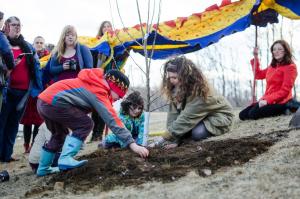 New Beginnings
New Beginnings
In April, the graduate programs officially joined the main campus in Marlboro, marking the new co-location with a ceremony including a dragon dance, gift giving, and tree planting. Photo by Clayton Clemetson
Taking Action
Claire Wheeler MBA ’14 checks in on a group discussion about curricular innovation, part of the Action Planning Process that was launched last summer to include faculty, staff, and students in putting our best ideas forward.
Student Power
On April 12, Work Day included installing a solar panel on the Outdoor Program barn to power a new electric-assist, compost-toting tricycle, along with the usual splitting wood, trimming apple trees, building benches, and picking up trash.
Sexual Respect
In February, the college convened a community discussion on Title IX policy, featuring a panel of specialists, from left to right: Chantelle Cleary (SUNY Albany Title IX coordinator), Jean Kiewel (Title IX coordinator), Jeff Nolan (attorney), Robyn Manning-Samuels (senior coordinator of sexual respect and wellness), Max Foldeak (director of health services), and Meg Mott (professor of politics).
 Tropical Paradise
Tropical Paradise
Senior Iain Haukka pauses by a waterfall during an Outdoor Program trip to Guadeloupe, in the Caribbean’s Leeward Islands, during Spring Break last March. Photo by Clayton Clemetson
Events
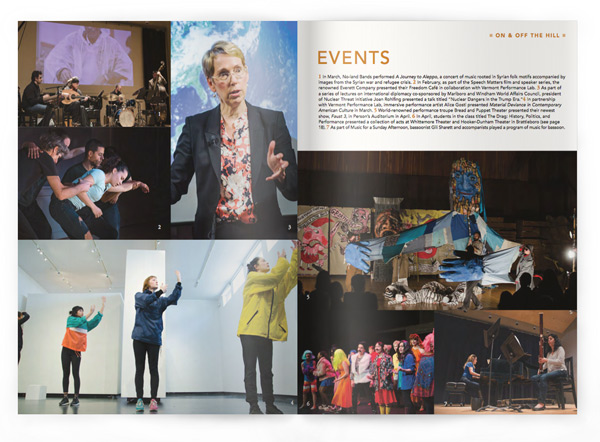
1 In March, No-land Bands performed A Journey to Aleppo, a concert of music rooted in Syrian folk motifs accompanied by images from the Syrian war and refugee crisis. 2 In February, as part of the Speech Matters film and speaker series, the renowned Everett Company presented their Freedom Café in collaboration with Vermont Performance Lab. 3 As part of a series of lectures on international diplomacy co-sponsored by Marlboro and Windham World Affairs Council, president of Nuclear Threat Initiative Joan Rohlfing presented a talk titled “Nuclear Dangers in the Trump Era.” 4 In partnership with Vermont Performance Lab, immersive performance artist Alice Gosti presented Material Deviance in Contemporary American Culture in March. 5 World-renowned performance troupe Bread and Puppet Theater presented their newest show, Faust 3, in Person’s Auditorium in April. 6 In April, students in the class titled Drag: History, Politics, and Performance presented a collection of acts at Whittemore Theater and Hooker-Dunham Theater in Brattleboro. 7 As part of Music for a Sunday Afternoon, bassoonist Gili Sharett and accompanists played a program of music for bassoon.
Focus on Faculty

Faculty Q&A
Last February, junior Emmett Wood sat down with music professor Matan Rubinstein to discuss composition, collaborating with students, and leading pop bands in the Israeli army. You can read the whole interview.
EMMETT WOOD: How would you characterize your early career in music?
MATAN RUBINSTEIN: I began at a very young age, playing piano. I got my first professional engagement around age 16. Then there was the army. In Israel, it’s a mandatory service of three years. I was an arranger for the army band, which is probably the least combatant job you could have in the army. The Israeli army has these small groups that go to entertain the troops, and so my job was to write arrangements and rehearse with those groups. It was really a ridiculous job. In a very, very loose sense, I’m a veteran.
E: Have you been composing recently?
M: I’m active all the time: I compose and I play. I just finished a commission for a solo cello piece, but I’ve done some music for dance. Two years ago I scored a documentary film soundtrack. So I’ve been doing music for film and dance. I never really stop.
E: And you’re always working with Plan students?
M: Yeah, improvisation, electronic music, some sound design.
E: What do you like about working with Marlboro students?
M: My favorite aspect of working with people here is how enthusiastic and open-minded they are—this is almost without exception. People come here and they are open to unorthodox ideas, and when that is coupled with discipline it’s really a remarkably good experience teaching here. It’s never dull. I get to hear thoughts that I never would have thought of myself, which is always a gift.
Focus on Faculty
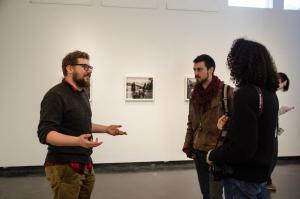 Professor of religion Amer Latif gave a talk at the June annual meeting of the Windham World Affairs Council titled “An Islamic Christmas Tree: Insights from Cognitive Science on Making Peace.” His presentation outlined a way to forge a rigorous method for making peace, at a deep level, between apparent religious contradictions—a way of finding harmony and unity that accommodates difference and multiplicity. Amer also discussed how this method appears from the perspective of contemporary cognitive science on the nature of human understanding. He is currently working on a book titled “Only God is Good”: Islam in the Words of Jesus.
Professor of religion Amer Latif gave a talk at the June annual meeting of the Windham World Affairs Council titled “An Islamic Christmas Tree: Insights from Cognitive Science on Making Peace.” His presentation outlined a way to forge a rigorous method for making peace, at a deep level, between apparent religious contradictions—a way of finding harmony and unity that accommodates difference and multiplicity. Amer also discussed how this method appears from the perspective of contemporary cognitive science on the nature of human understanding. He is currently working on a book titled “Only God is Good”: Islam in the Words of Jesus.
In May, retiring writing and literature teacher T. Hunter Wilson regaled students, faculty, and other admirers in the library reading room with a retrospective reading of his work. Ominously titled “The Final Reading,” the event featured some prose, including essays about his travels in Vietnam and Laos, but mostly poems, including old, recent, and new work.
Management co-chair Lori Hanau was thrilled to interview Anahita Joon Tehrani in support of the transformational coach’s project to convene a “new women’s movement” as a global virtual summit. “It has been my deep privilege to be part of a project that seeks to bring forth the nurturing powers of the sacred feminine to heal and unite, during a time when separation and fear are dominating our airwaves,” says Lori. Her interview, titled “The Undefended Heart: Upgrading Our Humanity through Shared Leadership,” is part of a series available by donation (all proceeds go toward ending human trafficking and slavery) at thenewwomensmovement.com.
In February, the faculty convened an Indigenous Voices in Mesoamerica panel, a presentation and discussion about indigenous stories from Mexico, Guatemala, and Belize. The panel featured Spanish language and literature professor Rosario de Swanson, anthropology professor (emeritus) Carol Hendrickson, theater professor Jean O'Hara, and senior Trevor Avery, and was followed by a Mesoamerican-themed community dinner.
“In many ways, this task of developing engaged citizens echoes the quintessential role of higher education: developing lifelong learners,” says President Kevin Quigley in an April Huffington Post editorial titled “Citizenry Is Learned and Earned.” Kevin touts the essential role of higher education— specifically liberal arts colleges and universities—in ensuring that graduates become engaged citizens, and the importance of such citizens in the continued viability of our democracy. “At Marlboro College, citizen engagement is in our DNA. It is who we are and what we do.” Read more.
Photography professor John Willis has embarked on a collaborative project to create a new photo book on the Standing Rock Tribe’s movement against the Dakota Access Pipeline and on Oceti Sakowin Camp. Building on his own images from several visits to the camp, John is hoping to collect contributions of photos and voices of Native Americans, and to edit the book with a Native American contributor. “I hope the book will honor the indigenous- led movement, and we can represent the concept of working together in a new way while respecting the value of the Native-led approach to the movement,” said John. Learn more at jwillis.net.
In March, graduate faculty member and founder of the Women’s Leadership Circles program Kerry Secrest helped facilitate an open meeting in Brattleboro on the Vermont Equal Pay Compact, the employer pledge to close the gender wage gap. Also a member of the Vermont Commission on Women, Kerry was joined by Cary Brown, executive director of the Vermont Commission on Women, and Jackie Cook, of the Department of Labor’s Women’s Bureau. Marlboro College is a proud signatory of the Equal Pay Compact.
In April, philosophy professor William Edelglass gave a lecture for Earth Day at the University of Utah. He also recently gave a series of public lectures on the history of the concept of race. This summer, William gave a commencement address at his alma mater, St. John’s College, in Sante Fe. Among his publications this year is “Buddhism, Happiness, and the Science of Meditation,” in Meditation, Buddhism, and Science, edited by David L. McMahan and Erik Braun, published by Oxford University Press. Working with collaborators in Brattleboro, William recently received a $150,000 matching grant from the National Endowment for the Humanities to build community through humanities work.
“Through the retelling of her story, the poet claims blackness and African roots as pillars of Peruvian culture,” says Spanish language and literature professor Rosario de Swanson, referring to Afro-Peruvian writer Nicomedes Santa Cruz. Rosario published an article on Santa Cruz’s poem “Ritmos Negros del Perú” in a recent issue of Hispania, the flagship journal of the American Association of Teachers of Spanish and Portuguese. In her article, she argues that the poem opens the door for the “decolonization of Peruvian history and culture.” Meanwhile, Rosario was elected for appointment to the AP Spanish Literature and Culture Development Committee for Educational Testing Service (ETS), where she works during the summer.
In April, Marlboro screened the documentary Jim: The James Foley Story, followed by a discussion and Q&A by visiting politics professor Clare Gillis. The film tells the story of American photojournalist James Foley, who was kidnapped in Syria in 2012 and went missing for two years before the infamous video of his public execution sent shockwaves and introduced much of the world to ISIS. Clare is one of Foley’s journalist colleagues featured in the film, which includes intimate interviews with Jim’s family, friends, and other fellow journalists. She and Foley became close friends in 2011, when they were detained together in Libya by the Gaddafi regime. In July, Clare also gave a talk titled “Refugeehood from World War II until the Present,” part of a five-part series on refugees in the U.S., sponsored by the MA in TESOL program.
A special concert in the Music for a Sunday Afternoon series in April featured the compositions of retiring music professor Stan Charkey, the Luis C. Batlle Chair in Music and the driving force behind the venerable series. On the eve of his retirement, this retrospective program of Stan’s works was performed by friends, family, and colleagues Andrew Eng (violin and viola), Anya Shemetyeva Merfeld (viola), Jake Charkey (cello), Paul Cohen (cello), Greg Jukes (percussion), and fellow Marlboro professor Matan Rubinstein (piano). Over the years, many of these works premiered in Paris, Los Angeles, and Washington, and of course Marlboro.
“We come together as poets, novelists, short-story writers, memoirists. We are writers together, regardless of the experiences that brought us here,” says John Sheehy, professor of writing and literature. He reflects on Marlboro’s Summer Writing Intensive in his editorial “Taking the Fight to the Page,” which appeared in a January issue of The Chronicle of Higher Education. John has led the Summer Writing Intensive, geared toward bringing together veterans as well as civilians through the art of writing, since 2014. “Many of the veterans write about war, but not all of them,” Sheehy says. “So do many of the civilians.… We are writers together, regardless of the experiences that brought us here.” Read more.
Marlboro was the first college in Vermont to be included in a Google Expeditions college tour, allowing prospective college students to experience virtual visits to campuses across the U.S., thanks to the efforts of Caleb Clark, chair of the Teaching with Technology program. “Now Marlboro can be visited virtually by those who may not have the opportunity to make the trip in person, by using smartphones or tablets to ‘look around’ our beautiful campus and read about key points of interest,” said Caleb. He received a grant from Google, which provided a 360-degree camera kit to capture the campus. Learn more.
Student Art
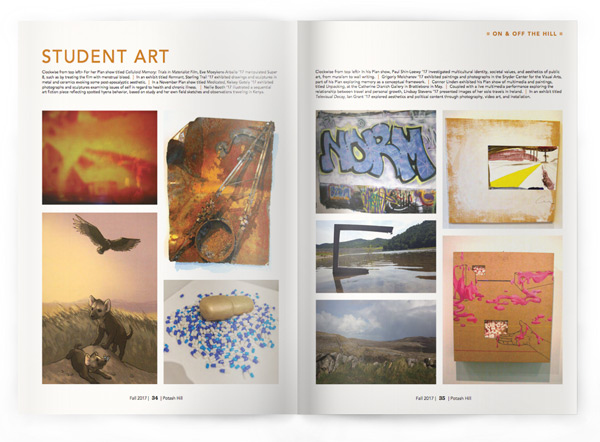
Left page, clockwise from top left> For her Plan show titled Celluloid Memory: Trials in Materialist Film, Eve Moeykens-Arballo ’17 manipulated Super 8, such as by treating the film with menstrual blood. | In an exhibit titled Remnant, Sterling Trail ’17 exhibited drawings and sculptures in metal and ceramics evoking some post-apocalyptic aesthetic. | In a November Plan show titled Medicated, Kelsey Gately ’17 exhibited photographs and sculptures examining issues of self in regard to health and chronic illness. | Nellie Booth ’17 illustrated a sequential art fiction piece reflecting spotted hyena behavior, based on study and her own field sketches and observations traveling in Kenya.
Right page, clockwise from top left> In his Plan show, Paul Shin-Loewy ’17 investigated multicultural identity, societal values, and aesthetics of public art, from muralism to wall writing. | Grigoriy Molchanov ’17 exhibited paintings and photographs in the Snyder Center for the Visual Arts, part of his Plan exploring memory as a conceptual framework. | Connor Linden exhibited his Plan show of multimedia and paintings, titled Unpacking, at the Catherine Dianich Gallery in Brattleboro in May. | Coupled with a live multimedia performance exploring the relationship between travel and personal growth, Lindsay Stevens ’17 presented images of her solo travels in Ireland. | In an exhibit titled Televisual Decay, Ian Grant ’17 explored aesthetics and political content through photography, video art, and installation.
2017 Commencement
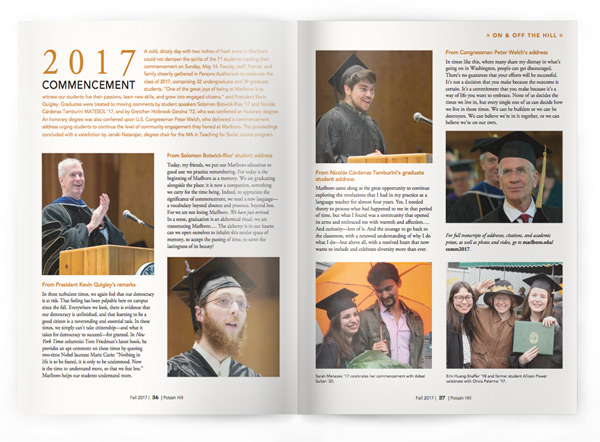
A cold, drizzly day with two inches of fresh snow in Marlboro could not dampen the spirits of the 71 students marking their commencement on Sunday, May 14. Faculty, staff, friends, and family cheerily gathered in Persons Auditorium to celebrate the class of 2017, comprising 32 undergraduate and 39 graduate students. “One of the great joys of being at Marlboro is to witness our students live their passions, learn new skills, and grow into engaged citizens,” said President Kevin Quigley. Graduates were treated to moving comments by student speakers Solomon Botwick-Ries ’17 and Nicolás Cárdenas Tamburini MATESOL ’17, and by Gretchen Holbrook Gerzina ’72, who was conferred an honorary degree. An honorary degree was also conferred upon U.S. Congressman Peter Welch, who delivered a commencement address urging students to continue the level of community engagement they honed at Marlboro. The proceedings concluded with a valediction by Janaki Natarajan, degree chair for the MA in Teaching for Social Justice program.
From President Kevin Quigley’s remarks
In these turbulent times, we again feel that our democracy is at risk. That feeling has been palpable here on campus since the fall. Everywhere we look, there is evidence that our democracy is unfinished, and that learning to be a good citizen is a neverending and essential task. In these times, we simply can’t take citizenship—and what it takes for democracy to succeed—for granted. In New York Times columnist Tom Friedman’s latest book, he provides an apt comment on these times by quoting two-time Nobel laureate Marie Curie: “Nothing in life is to be feared, it is only to be understood. Now is the time to understand more, so that we fear less.” Marlboro helps our students understand more.
From Solomon Botwick-Ries’ student address
Today, my friends, we put our Marlboro education to good use: we practice remembering. For today is the beginning of Marlboro as a memory. We are graduating alongside the place: it is now a companion, something we carry for the time being. Indeed, to appreciate the significance of commencement, we need a new language— a vocabulary beyond absence and presence, beyond loss. For we are not losing Marlboro. We have just arrived. In a sense, graduation is an alchemical ritual: we are transmuting Marlboro.… The alchemy is in our hearts: can we open ourselves to inhabit this tender space of memory, to accept the passing of time, to savor the lastingness of its beauty?
From Nicolás Cárdenas Tamburini’s graduate student address
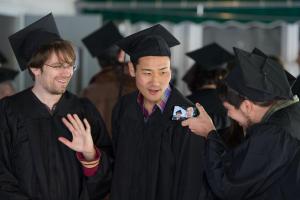 Marlboro came along as the great opportunity to continue exploring the revelations that I had in my practice as a language teacher for almost four years. Yes, I needed theory to process what had happened to me in that period of time, but what I found was a community that opened its arms and embraced me with warmth and affection.… And curiosity—lots of it. And the courage to go back to the classroom, with a renewed understanding of why I do what I do—but above all, with a resolved heart that now wants to include and celebrate diversity more than ever.
Marlboro came along as the great opportunity to continue exploring the revelations that I had in my practice as a language teacher for almost four years. Yes, I needed theory to process what had happened to me in that period of time, but what I found was a community that opened its arms and embraced me with warmth and affection.… And curiosity—lots of it. And the courage to go back to the classroom, with a renewed understanding of why I do what I do—but above all, with a resolved heart that now wants to include and celebrate diversity more than ever.
From Congressman Peter Welch’s address
In times like this, where many share my dismay in what’s going on in Washington, people can get discouraged. There’s no guarantee that your efforts will be successful. It’s not a decision that you make because the outcome is certain. It’s a commitment that you make because it’s a way of life you want to embrace. None of us decides the times we live in, but every single one of us can decide how we live in those times. We can be builders or we can be destroyers. We can believe we’re in it together, or we can believe we’re on our own.
See full transcripts of addresses, citations, and academic prizes, as well as photos and video.
Alumni News
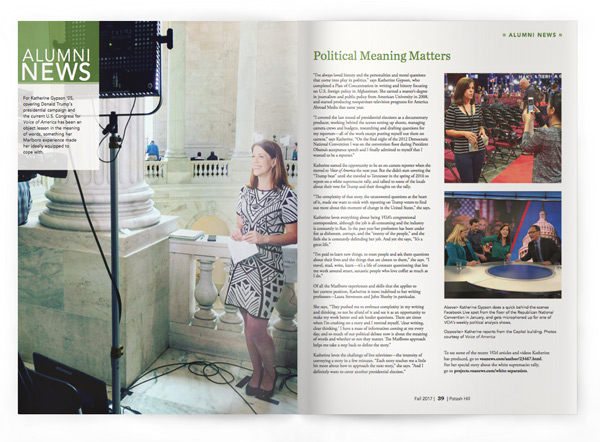
Political Meaning Matters
For Katherine Gypson ’05, covering Donald Trump’s presidential campaign and the current U.S. Congress for Voice of America has been an object lesson in the meaning of words, something her Marlboro experience made her ideally equipped to cope with.
“I’ve always loved history and the personalities and moral questions that come into play in politics,” says Katherine Gypson, who completed a Plan of Concentration in writing and history focusing on U.S. foreign policy in Afghanistan. She earned a master’s degree in journalism and public policy from American University in 2008, and started producing nonpartisan television programs for America Abroad Media that same year.
“I covered the last round of presidential elections as a documentary producer, working behind the scenes setting up shoots, managing camera crews and budgets, researching and drafting questions for my reporters—all of the work except putting myself out there on camera,” says Katherine. “On the final night of the 2012 Democratic National Convention I was on the convention floor during President Obama’s acceptance speech and I finally admitted to myself that I wanted to be a reporter.”
Katherine earned the opportunity to be an on-camera reporter when she moved to Voice of America the next year. But she didn’t start covering the “Trump beat” until she traveled to Tennessee in the spring of 2016 to report on a white supremacist rally, and talked to some of the locals about their vote for Trump and their thoughts on the rally.
“The complexity of that story, the unanswered questions at the heart of it, made me want to stick with reporting on Trump voters to find out more about this moment of change in the United States,” she says.
Katherine loves everything about being VOA’s congressional correspondent, although the job is all-consuming and the industry is constantly in flux. In the past year her profession has been under fire as dishonest, corrupt, and the “enemy of the people,” and she feels she is constantly defending her job. And yet she says, “It’s a great life.”
“I’m paid to learn new things, to meet people and ask them questions about their lives and the things that are closest to them,” she says. “I travel, read, write, learn—it’s a life of constant questioning that lets me work around smart, sarcastic people who love coffee as much as I do.”
Of all the Marlboro experiences and skills that she applies to her current position, Katherine is most indebted to her writing professors—Laura Stevenson and John Sheehy in particular. She says, “They pushed me to embrace complexity in my writing and thinking, to not be afraid of it and see it as an opportunity to make my work better and ask harder questions. There are times when I’m crashing on a story and I remind myself, ‘clear writing, clear thinking.’ I have a mass of information coming at me every day, and so much of our political debate now is about the meaning of words and whether or not they matter. The Marlboro approach helps me take a step back to define the story.”
Katherine loves the challenge of live television—the intensity of conveying a story in a few minutes. “Each story teaches me a little bit more about how to approach the next story,” she says. “And I definitely want to cover another presidential election.”
See some of the recent VOA articles and videos Katherine has produced, or her special story about the white supremacist rally.
Class Notes
Class notes are listed by year and include both graduates and nongraduates; the latter are listed under the class with which they are associated.
’59 “Downsizing—at our age we do not need 75 acres and two houses,” write BARBARA and BRUCE COLE. “Sorry to lose John MacArthur—a dear friend and professor.”
’63
“I’ve been involved in writing for quite a while,” says JON POTTER. “Currently I’m teaching creative writing at University College at Rockland, or ‘U-Rock.’ I’ve published a number of poems, most recently in the Goose River Anthology. I’ve had quite a few plays published, some by Baker’s, Players Press, and most recently JAC. JAC even published a collection of ten commedia dell’ arte pieces that I put together for my local commedia troupe. The troupe operates on a stage built on a trailer, so in the summer we can produce plays in different areas. My first experience with commedia was at Marlboro. I wrote a textbook called The First Year English Teacher’s Guide to Beartraps, published by Xlibris, which was intended to deal with the real issues most first-year high-school English teachers face, and which are normally not explored in graduate classes in education. The subtitle is 103 Ways to Avoid Common Teaching Errors. My novel, published three years ago, is called We Will What We Will. It’s available in various formats through Amazon, and explores a group of high-school girls who have decided to ignore the ‘rules’ and get what they want when they want it. Thanks to Marlboro I’m still writing, and loving it.”
’68
“Roxanne and I are retired,” writes RICHARD NICKERSON. “It’s great to be away from the grind. We have two grandchildren and avoid complainers at all costs. Life is good but goes by oh so quickly.”
“Been retired nearly six years from serving as business manager at St. Luke Catholic Church and School,” says JOSHUA ADAMS. “That was my seventh career—I move on after 5–7 years at one place. Reunited with a high school classmate after no contact for 40 years, and we’ve been together now for 15 years. Ran my high school’s 45th and 50th reunions and I’m now being conned into running the 55th. Enjoying retirement—every day is Saturday except for Sunday. Spend my time walking my neighborhood, picking up litter—keeps me busy and out in the air. Hope all at Marlboro are doing well. Marlboro taught me so much that I never realized I’d learned until many years later. The college was truly a game changer for me.”
’70 “Still living in Camden, Maine, and painting,” says DAN DALY. “Show in galleries in Rockland and Portland, and teach at the Maine State Prison. Also president of the Georges River Chapter of Trout Unlimited. Go to its website for a movie on a conservation project I worked for.”
’72
GRETCHEN HOLBROOK GERZINA was chair of the jury that selected the finalists for the Pulitzer Prize for Biography or Autobiography, which was won by Hisham Matar, author of The Return: Fathers, Sons and the Land in Between. “We read all the hundreds of submissions and put forward our selections. It was a huge amount of work,” says Gretchen. She was also recently elected to the American Academy of Arts and Sciences.
“A new grandchild, Kelsey Jane Kim, was born December 2016,” writes MARGARET KELSEY WRIGHT. “Enjoying visits with her big brother Andrew, age 12, in LA, too. Our three grandchildren all doing interesting things. I am playing benefit concerts for organizations with ESL programs for immigrants and refugees. All is well here.”
’73
“It was through osmosis that I learned how to use my hands,” artist MICHELLE HOLZAPFEL says in an April article in the Brattleboro Reformer. “Art lives in the realm of possibility. It’s always hard—it never gets easier. It humbles you.” That same week Michelle was featured in PBS’s Craft in America series. Learn more.
“Was it 1970 when Grazers was started?” writes ANDRA HORTON, who submitted a recipe to a new Marlboro Community Cookbook that started with retired anthropology professor Carol Hendrickson’s Food and Culture class. “There was no alternative kitchen, and no meals for vegetarians. Several of us explained the situation to Roland Boyden, then dean of students (I think), wondering if there could be an alternate kitchen that would be supported in part by our meals money, and that was the beginning of Grazers. It was in the geodesic dome: Michelle at the stove, frying up onions and carrots and boiling brown rice ... Now, 47 years later and still a vegetarian, I can continue to conjure up those smells as I prepare my own stir-fry.”
’76
“I am a scholar of science, philosophy, and the arts,” writes MARTIN ROSENBERG. “I have published on most of the arts, and am currently researching the philosophical implications of the cognitive neuroscience of jazz improvisation. I am also a practicing jazz musician, composer, and arranger, and have had a two-night-a-week gig playing Jazz Happy Hour at a pub in Carnegie, Pennsylvania, for the last two-and-a-half years, currently with harmonica virtuoso Clint Hoover and bassist Michael McCarthy. I gave an invited paper for a music conference at the University of Southern Denmark last December 2016; was a featured speaker at the first Philosophy of Jazz Intermodal Conference in Winslow, Arizona, this past May 2017; and also performed during the conference jam session with philosopher Charles Otwell, pianist and composer for Poncho Sanchez.” Learn more.
’77
In July, KEVIN MCCAMANT, father of IAN ’12 and EMMA ’14, took a stand against urban violence and changed the conversation in Baltimore with a hunger strike. Learn more.
Habits of Attention: Jake Davis ’03
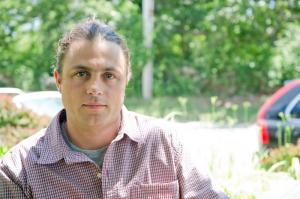 “Marlboro helped me to integrate my personal and academic interests—in training good habits of attention—into a more coherent whole,” says Jake Davis, who did his World Studies internship studying meditation in a Burmese monastery. “In a certain way, that’s still what I’m working on, though with an increasingly broad range of practices and cultures.” Since November, Jake has been working as a postdoctoral associate with New York University’s Virtues of Attention project, which investigates attention from cross-cultural philosophical perspectives.
“Marlboro helped me to integrate my personal and academic interests—in training good habits of attention—into a more coherent whole,” says Jake Davis, who did his World Studies internship studying meditation in a Burmese monastery. “In a certain way, that’s still what I’m working on, though with an increasingly broad range of practices and cultures.” Since November, Jake has been working as a postdoctoral associate with New York University’s Virtues of Attention project, which investigates attention from cross-cultural philosophical perspectives.
“My job is to cultivate a network of researchers working on this topic, hold workshops across NYU’s global network, and edit publications that will include philosophical contributions from Buddhist, Indian, Chinese, Islamic, Jewish, ancient Greek, African, Indigenous American, Polynesian, and Australian perspectives.”
Before his work at NYU, Jake was an adjunct professor for the Contemplative Studies Concentration at Brown University, teaching Buddhist Ethical Theory, Theory and Practice of Buddhist Meditation, and Meditation and the Brain. He earned his master’s degree in philosophy at University of Hawai‘i, and then a PhD at City University of New York, concentrating on the role of mindful attention in ethics.
“My favorite part of the NYU job is engaging with so many really interesting people, and talking and thinking with them beyond and around my own Buddhist and Western perspectives on things,” says Jake. “I still think of things Jet Thomas and Lynette Rummel said to me all those years ago. Some of their questions I have better answers for now, some not so much.”
’82
ABBY JACOBSON writes, “I’m back in Putney, Vermont, after living in Providence, Rhode Island, for three years, where I was often found hanging out with GERALDINE MCPHEE ’83 and her husband, TREVOR ALLEN ’85. Since my return to Vermont, I’ve started a new career path and am now the program coordinator at Putney Cares, a small nonprofit that helps Putney elders age in place at home. When I’m not at Putney Cares, I can be found at Hidden Springs Maple, also located in Putney, where I do retail work selling maple syrup and other local products. Would love to see any Marlboro alumni who pass through Putney.”
“Have applied to Vermont Law School, for environmental law, and been accepted,” says BRAD OLDENBURG.
’88
“Life is good,” writes KATHRYN WRIGHT APENES. “I am living in Portland, Oregon, with my husband, two golden retrievers, and a cat. I became an empty nester when my kids left for college. I work full time as a graphic designer and art director. I love to oil paint. You can see my art at kwastudio. com or at etsy.com/shop/kwaart.”
’89
JAMES CLARKE writes, “After 10 years of running my own educational consulting practice, I am now back in Maine, running Deck House (again), and very happily married to my beautiful Lauren (1/1/16). Our lives are kept very busy by attending school and sporting events for our combined four kids (21, 18, 13, and 10). Life is good.”
’91 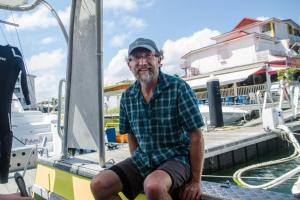 CJ CHURCHILL completed his training in psychoanalysis in May at the Contemporary Freudian Society. He also became a Fellow of the International Psychoanalytical Society and a Fellow of the College of the International Journal of Psychoanalysis. He has a practice in psychotherapy and psychoanalysis in midtown Manhattan, next to the New York Public Library, and continues as professor of sociology at St. Thomas Aquinas College. He recently published an article “‘Is That All There Is?’: Time, Guilt, and Melancholia in Sleep No More and Macbeth,” in the International Journal of Applied Psychoanalytic Studies. Learn more.
CJ CHURCHILL completed his training in psychoanalysis in May at the Contemporary Freudian Society. He also became a Fellow of the International Psychoanalytical Society and a Fellow of the College of the International Journal of Psychoanalysis. He has a practice in psychotherapy and psychoanalysis in midtown Manhattan, next to the New York Public Library, and continues as professor of sociology at St. Thomas Aquinas College. He recently published an article “‘Is That All There Is?’: Time, Guilt, and Melancholia in Sleep No More and Macbeth,” in the International Journal of Applied Psychoanalytic Studies. Learn more.
’93
Santorini, South Africa, Scotland, and Guilford, Vermont? Congratulations to DAVE SNYDER, founder and owner of Guilford Sound, for being named in the BBC’s list of the “10 most stunning places to make music.” The article touts accommodations “either in an eco-building with a living roof (the whole studio was designed with sustainability in mind) or an 18th-century farmhouse, with breath-taking views of the woodlands of southern Vermont.” Learn more.
’94
“Working for the USPS now as a clerk in Bellows Falls, Vermont,” writes CARLA FOGG. “Very different than academia. Enjoying the historical aspect and postage stamps. Money pretty good, too.”
’95
“Life in Ohio is good,” writes MIKE TEMPLETON. “I make my living as a cook. I live in a little ‘city nest’ in Cincinnati, with a lovely woman who is an artist. Still living as a perpetual Marlboro dreamer...I write a blog on Wordpress should any of the lit philosophy weirdos get interested in what an old alumnus gets up to. It is partially the legacy of being one of Birje’s Plan students.” Learn more.
’96
“I was assistant editor on the sixth and last season of Grimm on NBC,” says ERIN PETERS. “Then I went to a pilot for CBS called The Get about Vice News–style reporters. It starred Amy Brenneman from Judging Amy and Brad Garrett from Everybody Loves Raymond. I guess by the time you read this we’ll all know if it was picked up or not.”
’97
“I don’t feel anyone should be able to just spoon-feed somebody their liberal or conservative politics or scientific opinions based on their own points of view,” said MICHAEL AUERBACH in a January Brattleboro Reformer article titled “Learning to Discern Fact from Faux News.” “I want students to investigate how we can really tell if something is valid or true.” Michael was featured for teaching a course centered around climate change, and discerning fabricated from factual data, at Brattleboro Union High School. Learn more.
“Living not too far from campus in Shelburne Falls, Massachusetts, with my wife, Rachel, and our four-legged kids, Ozzy (cat) and Magick (dog),” writes AARON TIEGER. “Still practicing psychotherapy, both for an agency in the hilltowns and from my home office. My second full-length book of poems, Chaos Flowers, is due to be published sometime this year, and Rachel and I are still playing music together as Catbasket, though we are on semi-hiatus as she is working on a PhD in marriage and family therapy. I spend much of my time noodling around on acoustic guitars and posting the results on Soundcloud. Life is weird and challenging and overall delightful.”
The OP Goes to Boston: Rik Ganguly ’10 and Ari Iaccarino ’10
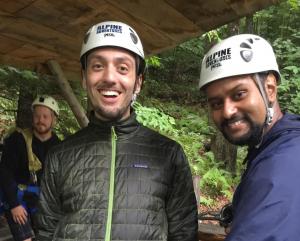 A couple of years ago, on the drive home from a nine-hour hike in the White Mountains, Rik Ganguly and Ari Iaccarino had the following conversation: “Hey, how do you get out here if you don’t have a car?” “I don’t know, but we should start a business to make it happen.” They were both in grad school and working full time in the Boston area, but that didn’t keep them from starting Ridj-it, a carpool company devoted to getting more people to explore the outdoors.
A couple of years ago, on the drive home from a nine-hour hike in the White Mountains, Rik Ganguly and Ari Iaccarino had the following conversation: “Hey, how do you get out here if you don’t have a car?” “I don’t know, but we should start a business to make it happen.” They were both in grad school and working full time in the Boston area, but that didn’t keep them from starting Ridj-it, a carpool company devoted to getting more people to explore the outdoors.
“Meeting cool people and getting outside is actually quite difficult in the city, versus at that great little school Marlboro, surrounded by forest,” says Ari, who is an ESL teacher for refugees and foreign diplomats when he is not traipsing in the New England wilds. “Every time someone tells us that we helped save them from getting a car and that our service fulfills their needs for adventure, the sense of satisfaction is overwhelming.”
Both Rik and Ari credit Marlboro with preparing them for the independent work and research required in their start-up business, and in the real world in general. “The ability to take multiple sources of information and, through problem solving, coalesce them into something comprehensible and actionable is a mindset, not a skill, that you learn at Marlboro,” says Rik, who works in healthcare analytics. “We use everything— art, literature, music, science, psychology, math—all the fields that a liberal arts degree provides, and that is invaluable in the age of automation.”
Find more information and see Leslie Wilson ’12 star in their promotional video.
’02
TIM COLLINS returned to Brattleboro in April to perform The Script, his one-man show examining rape culture and the attitudes that create an environment where violence against women is acceptable and normal. His benefit performance at the Brattleboro Museum and Art Center was sponsored by the Women’s Freedom Center as part of Sexual Violence Awareness Month.
’03
“I am elated to announce the birth of our second child, Meera Rosario, and another new beginning for my career,” says AMANDA TINNIN. “I have completed my PCI parent coaching certification. The program is an ideal fit for any Marlboro College community member as it involves a co-constructive process aimed at individuals within a living system rather than a one-size-fits-all framework. Our family will be staying in the UAE.”
’04
ANDREA MICHELLE BELAIR writes, “Hi, I’m married and live in New Haven, Connecticut, where I work as archivist at the Office of the President at Yale University. I loved my studies at Marlboro, I love Vermont, and I hope everyone I was friends with at that time is doing well.”
’05 JUSTIN HUGHES writes, “Am teaching English in Java, Indonesia. Wife and son are well.”
’06
JIM GUCKENBERGER writes, “I lived in Brattleboro after graduation for about six years, until that didn’t work out anymore and I met my wife, Adrienne. We moved to Portland, Oregon, for about four years, until that didn’t work anymore either; then we decided to move back to Vermont. Currently working for Soteria House here in Burlington, a medication-free residential program for people recovering from psychosis. Still missing Marlboro, though I haven’t made it back to campus since returning to Vermont last fall.”
’07
“If you look at a Native woman as a microcosm of the tribe, she may have been wounded in her lifetime and by historical trauma, but she is finding her strength and transforming that into a source for social change,” says WILLOW O’FERAL in Take magazine in May. She and BRAD HECK ’04 are featured for their new film, Arming Sisters, about combating increased rates of violence against Native American women. Learn more.
“Hello Marlboro community,” writes LILLIAN HELEN GRAHAM. “Forbes and I purchased our first home two years ago in Roslindale. We are expecting our second child this August and our hearts could not be fuller. Roslindale is a wonderful little chunk of Boston, and we are really enjoying the neighborhood. I continue to photograph daily, and have been working on an ongoing series of Boston estate sales, as well as keeping active with my vintage tin jewelry business, Memory Relics.”
’08
“Every day, I get the chance to experiment with new materials and their relationship to one another, constantly testing their limitations and boundaries to find new forms,” says Chicago-based artist ERIC GUSHEE in a June profile in Luxe Daily. “It is this physicality of art via materiality, and the endless vocabulary the world gives us, that motivates me.” The article describes Eric’s use of discarded materials to create “seemingly animate work, characterized by strands of metal woven into organic, circular layers.” Learn more.
America in Transition: André Pérez ’10
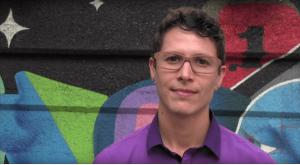 As a Puerto Rican trans man in the rural South, André Pérez vowed to create online resources for trans folks in rural communities. At Marlboro, André’s Plan included founding the Trans Oral History Project, a multimedia exhibit on the history of transgender activism. Almost a decade later, he is the director of America in Transition, a documentary series and community engagement campaign exploring community, family, and social issues for trans people of color across the United States.
As a Puerto Rican trans man in the rural South, André Pérez vowed to create online resources for trans folks in rural communities. At Marlboro, André’s Plan included founding the Trans Oral History Project, a multimedia exhibit on the history of transgender activism. Almost a decade later, he is the director of America in Transition, a documentary series and community engagement campaign exploring community, family, and social issues for trans people of color across the United States.
“I am excited to return to the South in order to explore and celebrate queer people fighting for the right to stay and creating space for ourselves in the communities we came from,” says André. “I want to talk about the South in complex and nuanced ways that go beyond the urban bias, and highlight the legacy of amazing queer culture that has managed to thrive, despite hostility.”
Over the past two years, André and colleagues have completed three episodes of America in Transition and hosted a dozen screenings focusing on the South. He builds on three years and over 500 interviews at StoryCorps, where he broadcasted 50 segments on NPR and WBEZ. In 2015, he was named one of the voices that will change the face of public media by the Association of Independent Radio, and in 2016 he was featured among NewCity Film’s 50 influential filmmakers in Chicago.
“Every day I get to learn from the incredible experiences of people in my own community, and that feels like a gift beyond measure,” says André. Learn more and support his efforts to change conversations in rural communities at americaintransition.org.
’11
“I love to make things,” says SOPHIE MUELLER in a July MV Times article about Jenni Bick Custom Journals of West Tisbury, on Martha’s Vineyard, where she runs a hydraulic stamping machine for embossing leather covers. “I did printmaking at Marlboro College and then for three years in Brattleboro. I feel at home here.” Learn more.
’13
CORA LIVELY writes, “I recently graduated from the University of Chicago MA program in social science and have taken a position in data modeling at the University of Chicago Medicine. I continue to be grateful for the professors at Marlboro who taught me how to make robust logical arguments and inspired me to pursue innovative solutions to complex problems. I see both of those skills carried into my current work in programming and analytics. I am also really grateful to have had the support of several Marlboro alumni, in my job search out of grad school, who were kind enough to talk to me about their experiences in tech. It is nice to see the Marlboro community carry on long after the hill.”
’14
ELISABETH JOFFE writes, “I live and work in DC as a membership advisor to boards of directors at the National Association of Corporate Directors, promoting and retaining members who want to continue their education in the profession of directorship.”
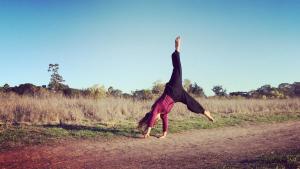 HANNAH RUTH BROTHERS reports, “I moved back to my hometown of Santa Barbara, California, where I met Matthew Nelson, a fellow dancer who had just started Guerrilla Dance Practice, in which he danced outside in a public location every day and then blogged about it. I enjoyed joining him for many of these outings, and felt empowered with the knowledge that I could dance anywhere. We danced at parks, on beaches, on a university campus, on neighborhood sidewalks, in a mall, in parking lots, in front of Trader Joe’s, and in the median on a busy street. We began exploring Guerrilla Dance Practice as an interesting and economical method of creating work. In early 2015, I performed “Resilient, Receptive,” a solo that Matthew choreographed during our Guerrilla practices, at HHII Dance Festival in Santa Barbara and SpectorDance in Monterey. I have since become devoted to this method for creating my own work, and debuted a solo, “Movin’ for Miles,” to sold-out audiences at Santa Barbara’s NECTAR last November and HHII Dance Festival in February of this year. “Miles” was inspired by the music of the first Miles Davis Quintet of the late 1950s, and explores the dancing body as an instrument in conversation with the quintet. It feels great to be creating and performing my own work on my own terms. But going solo gets a little lonely after a while—I have my sights set on a collaboration with another dancer friend of mine soon.”
HANNAH RUTH BROTHERS reports, “I moved back to my hometown of Santa Barbara, California, where I met Matthew Nelson, a fellow dancer who had just started Guerrilla Dance Practice, in which he danced outside in a public location every day and then blogged about it. I enjoyed joining him for many of these outings, and felt empowered with the knowledge that I could dance anywhere. We danced at parks, on beaches, on a university campus, on neighborhood sidewalks, in a mall, in parking lots, in front of Trader Joe’s, and in the median on a busy street. We began exploring Guerrilla Dance Practice as an interesting and economical method of creating work. In early 2015, I performed “Resilient, Receptive,” a solo that Matthew choreographed during our Guerrilla practices, at HHII Dance Festival in Santa Barbara and SpectorDance in Monterey. I have since become devoted to this method for creating my own work, and debuted a solo, “Movin’ for Miles,” to sold-out audiences at Santa Barbara’s NECTAR last November and HHII Dance Festival in February of this year. “Miles” was inspired by the music of the first Miles Davis Quintet of the late 1950s, and explores the dancing body as an instrument in conversation with the quintet. It feels great to be creating and performing my own work on my own terms. But going solo gets a little lonely after a while—I have my sights set on a collaboration with another dancer friend of mine soon.”
’15
After applying to the Young Adult Service Corps, a mission of the Episcopal Church, AMELIA BROWN was selected as intern in the communications office for the worldwide Anglican Communion in London, starting in September. “It’s not the typical placement, but I am so excited for it,” reports Amelia, who was chosen based on her strong communications background. “Some of the things I’ll be doing are social media, collecting stories for the Anglican News, and some more media-based projects.” Follow her.
“I work in the toddler room of ABC’s childcare center in New London, New Hampshire,” says HALEY PETERS. “While I work with the whole classroom, my job is to guide and care for the littler ones in the classroom.”
“I’m living in Brattleboro, after a brief time away, working with behaviorally challenged kids,” says ROSIE KAHAN. “I work in a residence and have a lovely apartment, walking distance to work. I’ve stayed very close with several of my Marlboro friends, and talk to them often.”
’16
In February, RAINBOW STAKIWICZ’s Plan show, Vox Pop, was performed at the American College Theater Festival at the Kennedy Center, in Danbury, Connecticut. “I was on campus a few days, working with my team to get it back in shape, and then it was seen by college students, scouts, and faculty from all across the northeast. I’m really blessed to have had this opportunity, and I could not have done it without the help and support of Marlboro College.”
FELIX JARRAR writes, “I have been selected by the Brooklyn College Scholarship Committee to receive a fellowship to become the assistant to the ConTempo ensemble in the spring of 2018. The ConTempo ensemble is the conservatory’s new-music ensemble run by the legendary and award-winning pianist Ursula Oppens.” Felix was interviewed by Broadway World, along with his collaborator Brittany Goodwin, regarding the June debut of their theatrical musical cycle Songs of the Soul Beams at the Brooklyn Academy of Music. “We wrote this work because we lost loved ones during the production of my second opera, The Fall of the House of Usher last year,” says Felix, referring to his Plan production. “Brittany, the director of the opera, lost her grandmother, and I lost my dealing with the grief of losing a loved one.” Learn more.
Graduate and Professional Studies
Teaching
’09
“I got my dream job! Or perhaps it’s more accurate to say I’m creating my dream job,” says REGGIE MARTELL MAT. “Since late in 2016 I’ve been working as the creative director of web and video services for Martin and Associates, helping K12 schools improve their websites and communications. Seeing the work these kids are doing gets you excited to tell their story and show the depth of their learning. It blows my mind.”
Management
’11
“My wife and I recently launched our own business, called Mindful Escapades,” says JOHN TEDESCO MBA. “We organize and run retreats in gorgeous locations around the world focused on mindfulness, adventure, and healing. Our first retreat will be in Riva del Garda, Italy, in September 2017, and will be a mindful adventure retreat with daily meditation, yoga, and outdoor adventures. We will hold our second retreat in Santa Teresa, Costa Rica, in March 2018, specifically for couples who have lived through cancer. It will be a loving and restorative celebration of life that will include yoga, meditation, surfing, massage, and the opportunity to be in a community of cancer survivors and caretakers. Please visit our website or send me an email directly for more information at mindfulescapades.com.”
Former Faculty and Staff
In February, retired biology professor BOB ENGEL gave a talk about plants, pollinators, and climate change, part of a lecture series titled “The Nature of Windham County: Past, Present, and Future,” co-sponsored by the Dummerston Conservation Commission and Bonnyvale Environmental Education Center. Bob discussed plants and pollinators that were here or that are here now, and what might affect them going forward in the context of “energetics.”
In March and April, the Dianich Gallery of Brattleboro, Vermont, was pleased to exhibit the work of the late painter GIB TAYLOR. The show featured large oils on canvas as well as watercolors, many painted in the artist’s Westminster West, Vermont, studio. Gib, who died in 2006, is fondly remembered not only for his artwork but also for his nearly 30-year tenure on the visual arts faculty at Marlboro College.
Former dean of students KEN SCHNECK was in Brattleboro for a reading and signing at the Root Social Justice Center in June, following the publication of his book, Seriously, What Am I Doing Here? The Adventures of a Wondering and Wandering Gay Jew. “This travelogue details my hilarious and heartbreaking adventures in the world, and my Vermont time and transition to Cleveland features heavily.” Learn more.
In Memoriam
David Decker ’60
A resident of Salem, Massachusetts, and Marlboro, Vermont, David Owen Decker died peacefully at Kaplan Family Hospice House in Danvers, Massachusetts, in March. Born in Toledo, Ohio, in 1936, he attended Asheville School and Woodstock Country School and graduated from Marlboro College, where he studied art. He then attended University of Wisconsin, Milwaukee, and graduated with a master’s degree in art and art history from New York University. David taught at the University of Maine, Orono, where he was a professor of design, architecture, and Canadian studies for 35 years. He exhibited his work in juried exhibitions at museums around the country. David was a lover of opera and chamber music, and as a Marlboro student he worked summers for the Marlboro Music Festival, which he later enjoyed and supported for over five decades. David was known for his generosity of spirit, his humor, and his ability to connect with people. David reunited with his “high-school sweetheart,” Lynn Latta Frothingham, after 40 years. He is survived by Lynn, as well as his sister, two stepchildren, and four grandchildren.
Peter Strickman ’67
A resident of Boston for more than 30 years, Peter Strickman died in January from pneumonia at Charlton Hospital in Fall River, his birthplace 70 years ago. Pete attended public schools in Fall River, then studied painting at Marlboro College with art professor Frank Stout. His outside examiner, renowned artist Wolf Kahn, said of his painting: “One feels in these works a gentle, slightly ironic, affectionate and generous personality.” Pete had several shows at galleries and museums in Providence, Newport, and New York City. Although he struggled with schizophrenia his whole life, he was a well-read scholar of religions and cultures— as well as many other fields of study—a poet, and a wonderful storyteller. His sister Bonnie said, “I like to think of him as a mystic with a deeply evolved inner life.” Several years ago, he found his home with the Roman Catholic Church and experienced great comfort, joy, and solace as an active member of the Paulist community in Boston. Pete is survived by his sister Bonnie, and his “adopted sister” Janie, along with many cousins and friends who will cherish his memory forever.
John Bell ’92
A resident of Malden, Massachusetts, John Justin Bell passed away unexpectedly in April. John was born in Wakefield, Rhode Island, in 1969, and graduated from South Kingstown High School. He went on to study at Marlboro College, where he did his Plan of Concentration in economics and biology, and then received a master’s degree in sociology from Boston College. John suffered from clinical depression, an illness he faced with unfailing courage. “I was envious of John for his brilliance,” said Michael Crane ’92. “I admired his ability to balance intellect and compassion.” John married Cheryl Harwood in 2009, and was a loving, devoted husband. For several years, John taught sociology at a number of colleges in the Boston area. A gifted musician, he played guitar and piano and had an eclectic music collection, constantly seeking out new and interesting CDs and albums. As of late, he was a volunteer tutor at a homeless shelter, where he got to share his gentle, patient, happy self with children who needed his attention as much as they needed his knowledge. John is survived by his wife Cheryl, his mother and stepfather, and his brother, along with numerous aunts, uncles, and cousins.
Matt Alling ’97
A resident of Salem, Massachusetts, and Latin teacher in the Marblehead public school system, Matt Alling died unexpectedly this spring. Born in Plymouth, Massachusetts, he went to Ledyard High School in Ledyard, Connecticut, before attending Marlboro. He completed his Plan of Concentration in classics and languages, specifically “A comparative study of ancient Indo-European languages focusing on verb morphology.” “His years at Marlboro were among the happiest of his life,” said his sister Emily Alling, who was library director at Marlboro for several years until 2014. “His friends, teachers, and studies, as well as the campus itself, were dear to him, and he spoke frequently of how much he cherished his time there. His work in classics at Marlboro led directly to a career that he loved and in which he excelled. He will be greatly missed by his family, friends, colleagues, and students. Anyone wishing to honor his memory through a donation is encouraged to give to Marlboro College.”
Kate Carr ’99
Sculptor Kate Carr died in April at her home in Santa Fe, of complications related to ovarian cancer. She was 40 years old. Born in Anchorage, Alaska, Kate did her Plan of Concentration at Marlboro in visual arts, specifically installation and art criticism. It was in Maine in 1999 that she met poet Jenny George, and they went on to make beautiful homes together in Mount Desert, Maine; Oxford, Iowa; Taos, New Mexico; and Brattleboro, Vermont, before settling in Santa Fe in 2007. Kate received her MFA in sculpture from the University of Iowa in 2005. In her artist statement Kate wrote, “I look for line in the world. It has a rhythm, a hum. It both differentiates space and connects it.” Kate had solo exhibitions in New York, Dallas, Marfa, and Santa Fe, and she received several fellowships. Kate brought the same contemplative attention she cultivated in her artwork to her yoga practice. In 2015, she traveled to Bali, a journey that profoundly transformed her life. She leaves her partner of 18 years, Jenny, as well as her mother, father, brother, other family members, and a close circle of friends.
Troy Wolfe FS’07
A resident of Seattle, Washington, Troy Richard Wolfe died in June at his home. He was 37. Troy was born in Killeen, Texas, and attended Tahoma High School in Maple Valley, Washington. After attending Marlboro College for three years, Troy returned to the Seattle area where he married Lauren Fortner. Together they started their own e-business creating websites, and Troy later went on to work for Amazon. Troy is survived by his son Anders, his mother and father, stepmother, sister, and brother, as well as grandmothers and many aunts, uncles, and cousins.
Andrew Bell, Classics Fellow
An Oxford Classics Fellow at Marlboro from 1985 to 1988, Andrew Bell died in his home in Las Vegas, Nevada, in June. Andrew received his degrees in classics from Oxford and Stanford Universities. He is the author of Spectacular Power in the Greek and Roman City, and taught history at University of Nevada, Las Vegas, since 1994. “When I hear the words ‘gentleman and scholar,’ I think of Andy,” said Mark Roessler ’90. “Thanks, Andy, for always insisting I have a glass of water after a night of drinking, and for always calling me ‘the Captain’ after once seeing me with a box of Captain Crunch cereal.”
Marlboro was disheartened to hear about the deaths of Chris Mahoney ’02 and Fran Nevins, former staff member and mother of John Nevins ’76, during production of Potash Hill. We will have full remembrances in the next issue.
Magnanimity Cum Laude
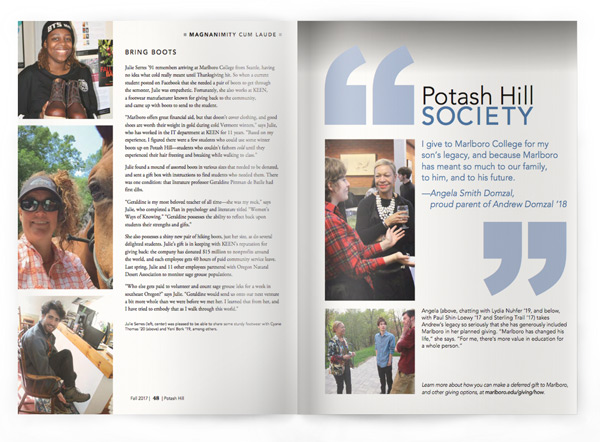
Bring Boots
Julie Serres ’91 remembers arriving at Marlboro College from Seattle, having no idea what cold really meant until Thanksgiving hit. So when a current student posted on Facebook that she needed a pair of boots to get through the semester, Julie was empathetic. Fortunately, she also works at KEEN, a footwear manufacturer known for giving back to the community, and came up with boots to send to the student.
“Marlboro offers great financial aid, but that doesn’t cover clothing, and good shoes are worth their weight in gold during cold Vermont winters,” says Julie, who has worked in the IT department at KEEN for 11 years. “Based on my experience, I figured there were a few students who could use some winter boots up on Potash Hill—students who couldn’t fathom cold until they experienced their hair freezing and breaking while walking to class.”
Julie found a mound of assorted boots in various sizes that needed to be donated, and sent a gift box with instructions to find students who needed them. There was one condition: that literature professor Geraldine Pittman de Batlle had first dibs.
“Geraldine is my most beloved teacher of all time—she was my rock,” says Julie, who completed a Plan in psychology and literature titled “Women’s Ways of Knowing.” “Geraldine possesses the ability to reflect back upon students their strengths and gifts.”
She also possesses a shiny new pair of hiking boots, just her size, as do several delighted students. Julie’s gift is in keeping with KEEN’s reputation for giving back: the company has donated $15 million to nonprofits around the world, and each employee gets 40 hours of paid community service leave. Last spring, Julie and 11 other employees partnered with Oregon Natural Desert Association to monitor sage grouse populations.
“Who else gets paid to volunteer and count sage grouse leks for a week in southeast Oregon?” says Julie. “Geraldine would send us onto our next venture a bit more whole than we were before we met her. I learned that from her, and I have tried to embody that as I walk through this world.”
Potash Hill Society
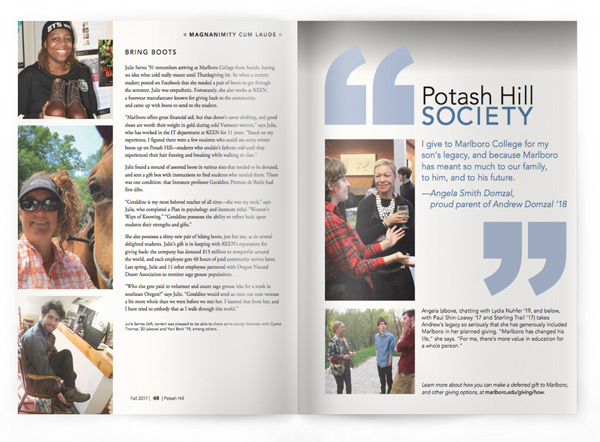
"I give to Marlboro College for my son’s legacy, and because Marlboro has meant so much to our family, to him, and to his future."
— Angela Smith Domzal, proud parent of Andrew Domzal ‘18
Angela (pictured chatting with Lydia Nuhfer ’19) takes Andrew’s legacy so seriously that she has generously included Marlboro in her planned giving. “Marlboro has changed his life,” she says. “For me, there’s more value in education for a whole person.”
Learn more about how you can make a deferred gift to Marlboro, and other giving options, at marlboro.edu/giving/how.
Special Web Features
Continuous Collaboration: An interview with Matan Rubinstein
Junior Emmett Wood sat down with music professor Matan Rubinstein to discuss composing music, performing, and collaborating with fellow colleague Stan Charkey, who retired last year.
Emmett: How long have you been teaching here?
Matan: This is my sixth year.
E: What is your curriculum like, and how has that developed?
M: Because there’s been two of us in the music department, my area was basically contemporary music making. And by contemporary, I mean the last century’s worth of time. Composers who are alive or recently dead. So I teach performance, composition, electronic music. I teach all sorts of critical subject matter that relates to these areas. Jazz history, criticism, popular music, experimental practices, and I continuously collaborate with my colleagues.
E: Have you been composing all the while that you’ve been here?
M: I’m active all the time, I compose and I play. I’m more active in New York and Massachusetts, less so around the immediate area. I perform usually once a year in our concert series. I just finished a commission for a solo cello piece, but I’ve done some music for dance. Two years ago I scored a documentary film soundtrack. So I’ve been doing music for film and dance. I never really stop.
E: What were you doing before you came to Marlboro?
M: I was in Wisconsin for about 10 years. I did my graduate studies there, and then was hired by one of the University of Wisconsin schools. So I was teaching jazz studies there.
E: How would you characterize your early career in music?
M: It’s hard to say when a decision has been made to undertake something. I began at a very young age, playing piano. I got my first professional engagement around age 16. My international tour was at the same age. I did my first film score when I was 17. Israel was nice. It was a nice small scene; it could get easy, relatively quickly. Then there was the army. In Israel, it’s a mandatory service of three years. In the army I was an arranger for the army band, which is probably the least combatant job you could have in the army. Along with the chief of staff it’s the only job where you only have one person doing it at a time. And so I had a relatively privileged existence at that point in the army. The Israeli army has a few branches that deal with music, one is marching bands, the other is pop bands—like if you remember the Bob Hope USO shows, stuff like that—kind of variety shows. The Israeli army has these very small groups that go to entertain the troops, and so my job was to write arrangements and rehearse with those groups. It was really a ridiculous job. In a very, very loose sense, I’m a veteran.
E: And you’re always working with Plan students?
M: Yeah, improvisation, electronic music, some sound design.
E: What would you say your favorite project is going on right now?
M: They’ve been very different. Last year, two of the most ambitious plans in the history of Marlboro came out of the music area, an opera, and a portfolio that was everywhere from sound sculpture to orchestra. I’m very proud.
E: What do you like about working with Marlboro students?
M: My favorite aspect of working with people here is how enthusiastic and open minded they are—this is almost without exception. People come here and they are open to unorthodox ideas, and when it is coupled with discipline it’s really a remarkably good experience teaching here. It’s never dull. It’s always interesting and often very rewarding. I get to hear thoughts that I never would have thought of myself, which is always a gift.
E: What did you enjoy about working with Stan Charkey?
M: Working with Stan has been a great privilege. His knowledge of a thousand years of music—you see it nowhere else. In a lot of ways, being with him has been like watching a master at work. He lives music in ways that are fundamentally inspiring. Stan and I presented an environment for students to go find out what they needed to by themselves, and we think about music making in many different ways. We provided a rich frame of reference for students. The thing to remember at Marlboro is that lots of teachers are constantly building on each other in ways that are not explicitly mentioned. There are all these networks that feed into each other. Music is very different from those, and it’s much harder to build this thick network with one person.
E: Any compositions that you’re working on right now?
M: I have two ongoing right now. I just finished one, and one is really long term. I’ll be on sabbatical next semester so I’ll get to do a long form piece. One is based on a medieval poetic form and the other is a weird tribute to Kurt Cobain. I’m collaborating with a student to build the software which will make the track.
E: Any other plans for sabbatical?
M: I am going to spend a few weeks by myself, which I haven’t done in 20 years. I’ll go to Israel for a little while to be in the desert, and there might be some things in Europe. I’ll be busy.